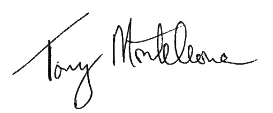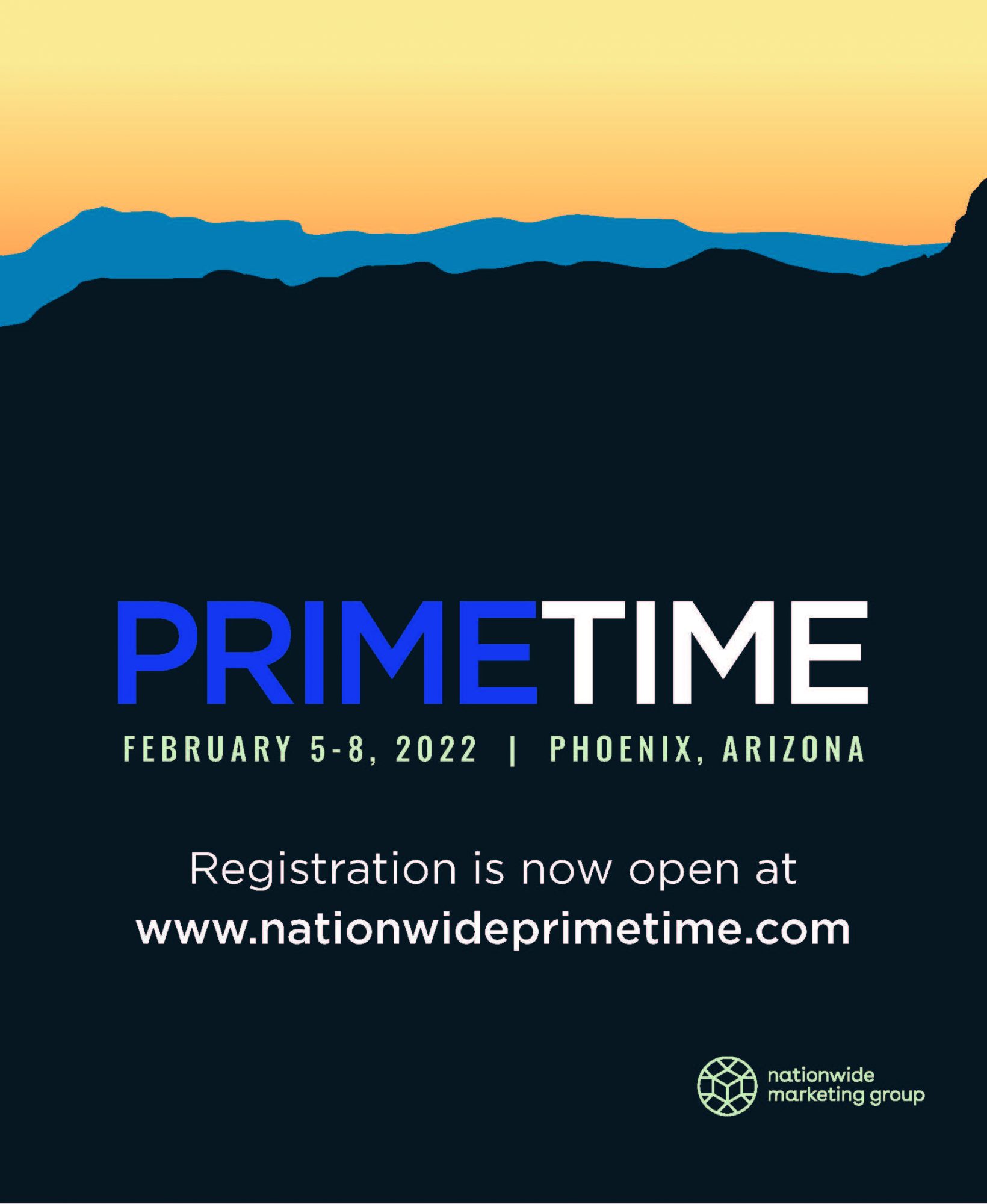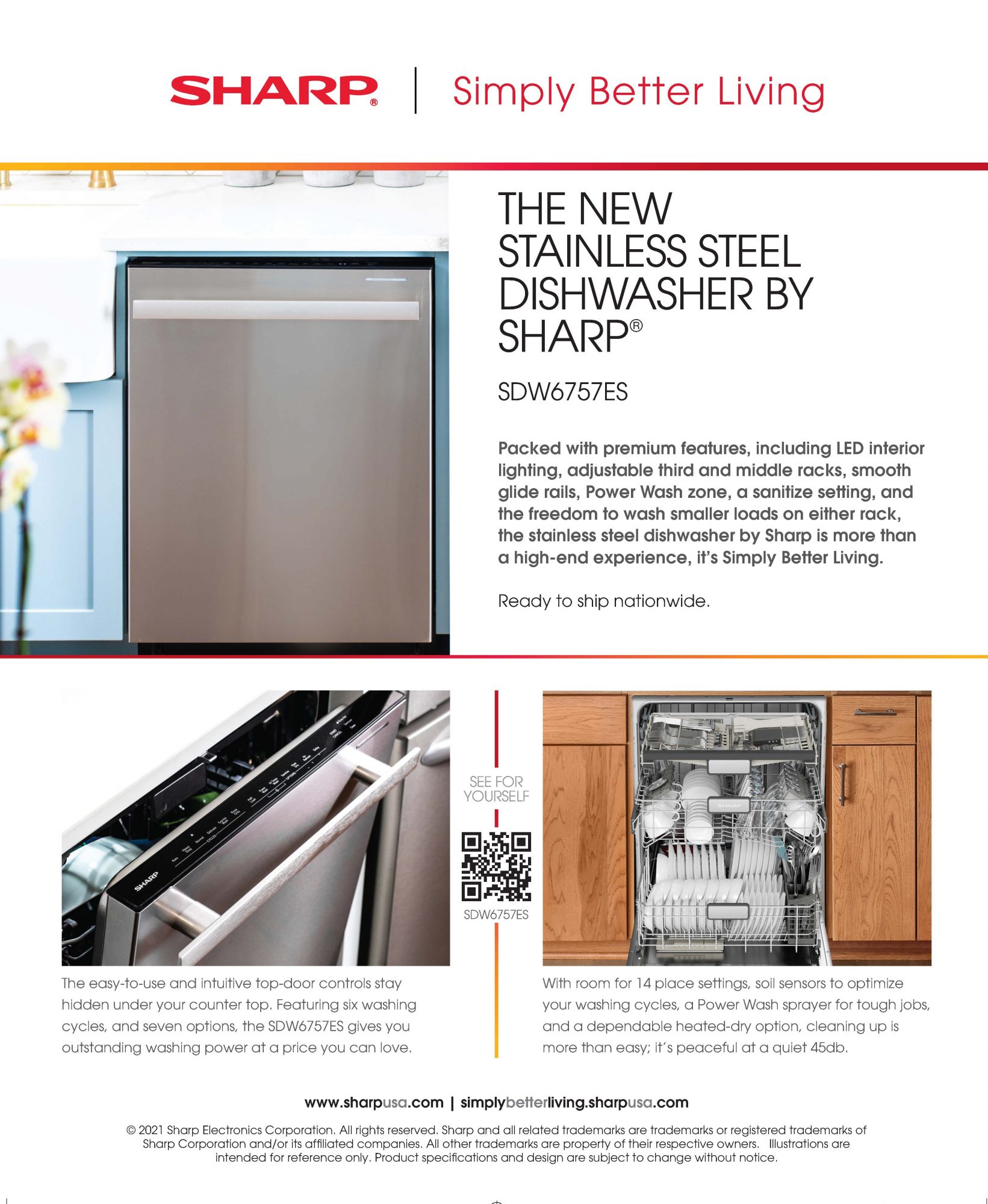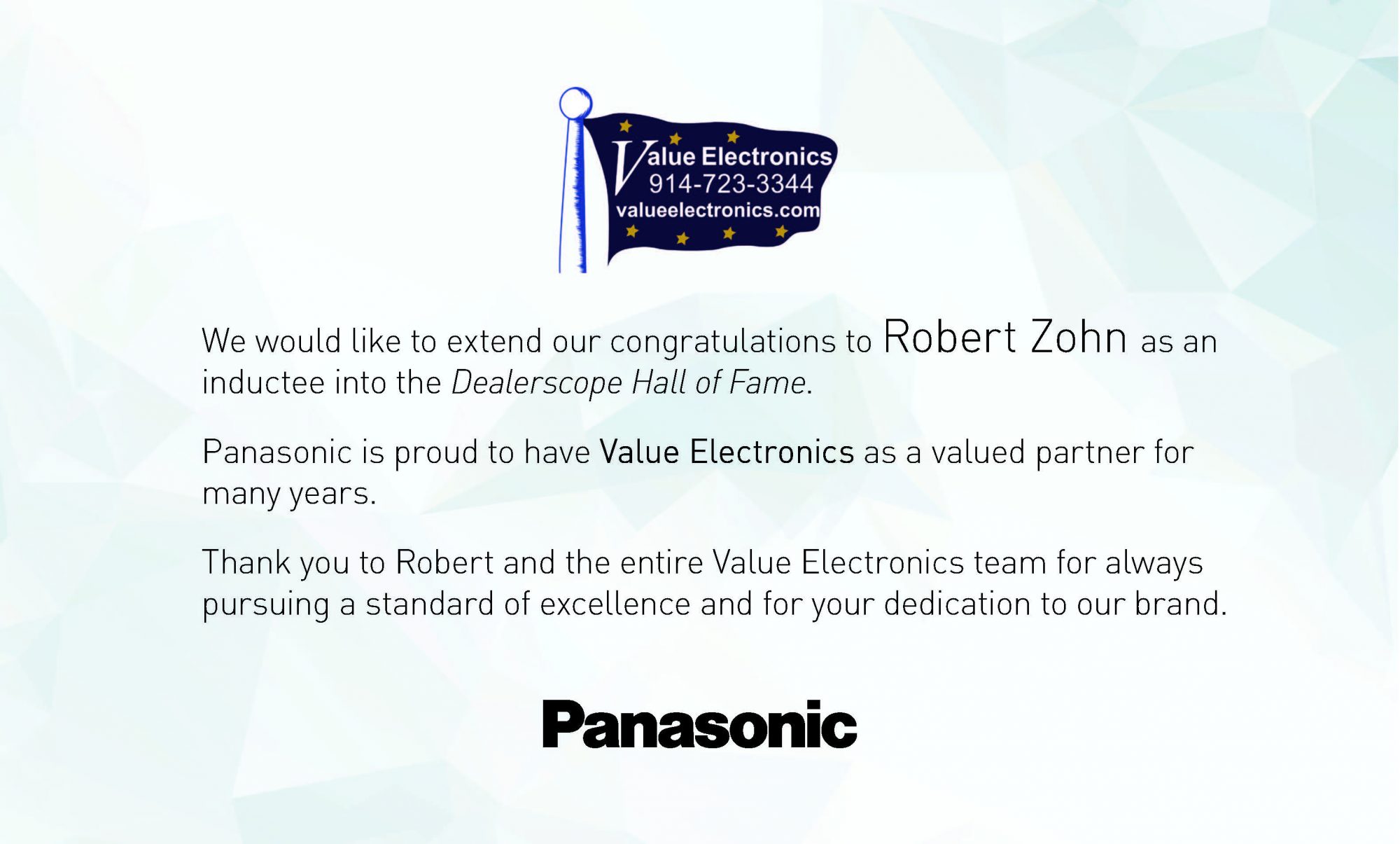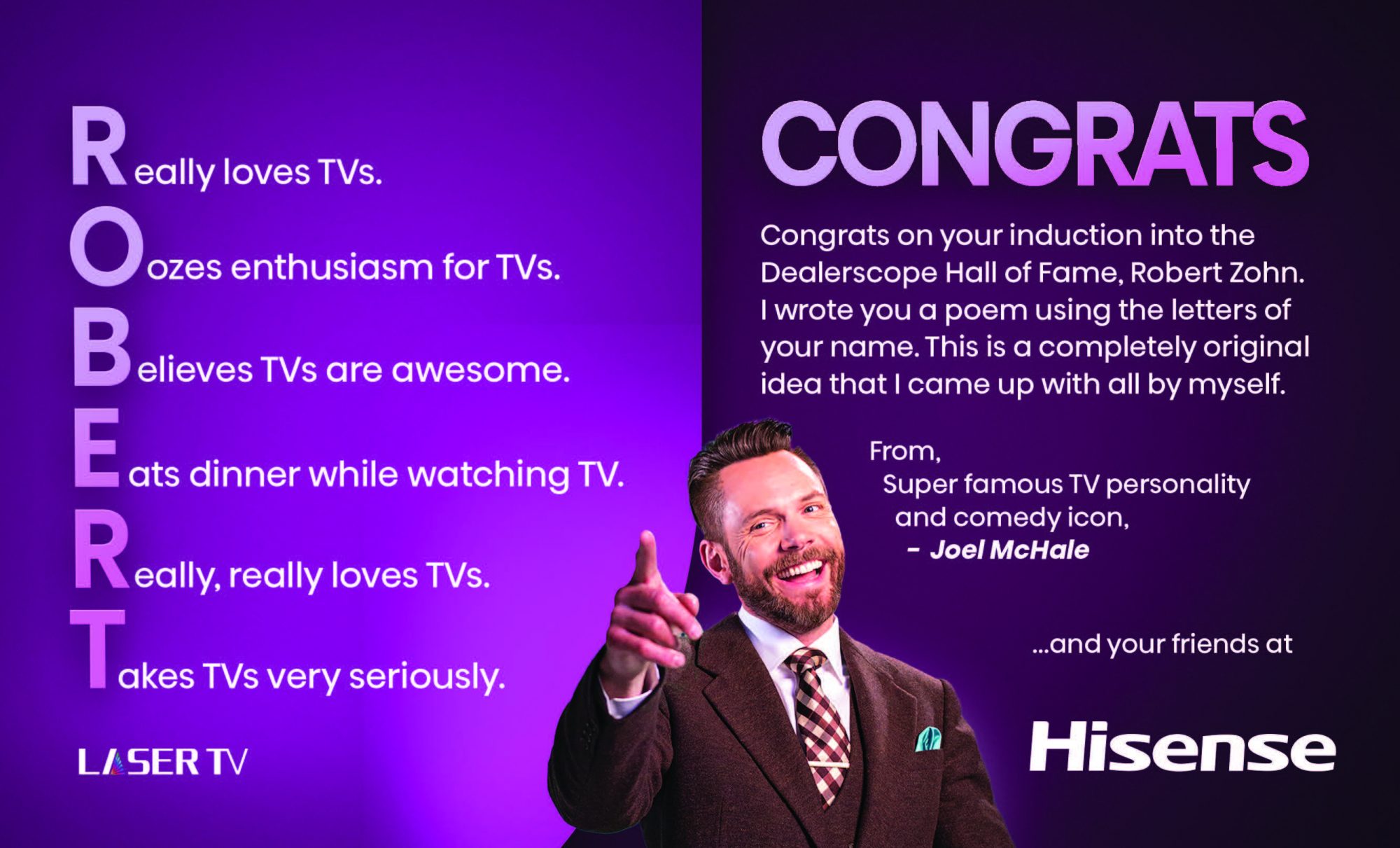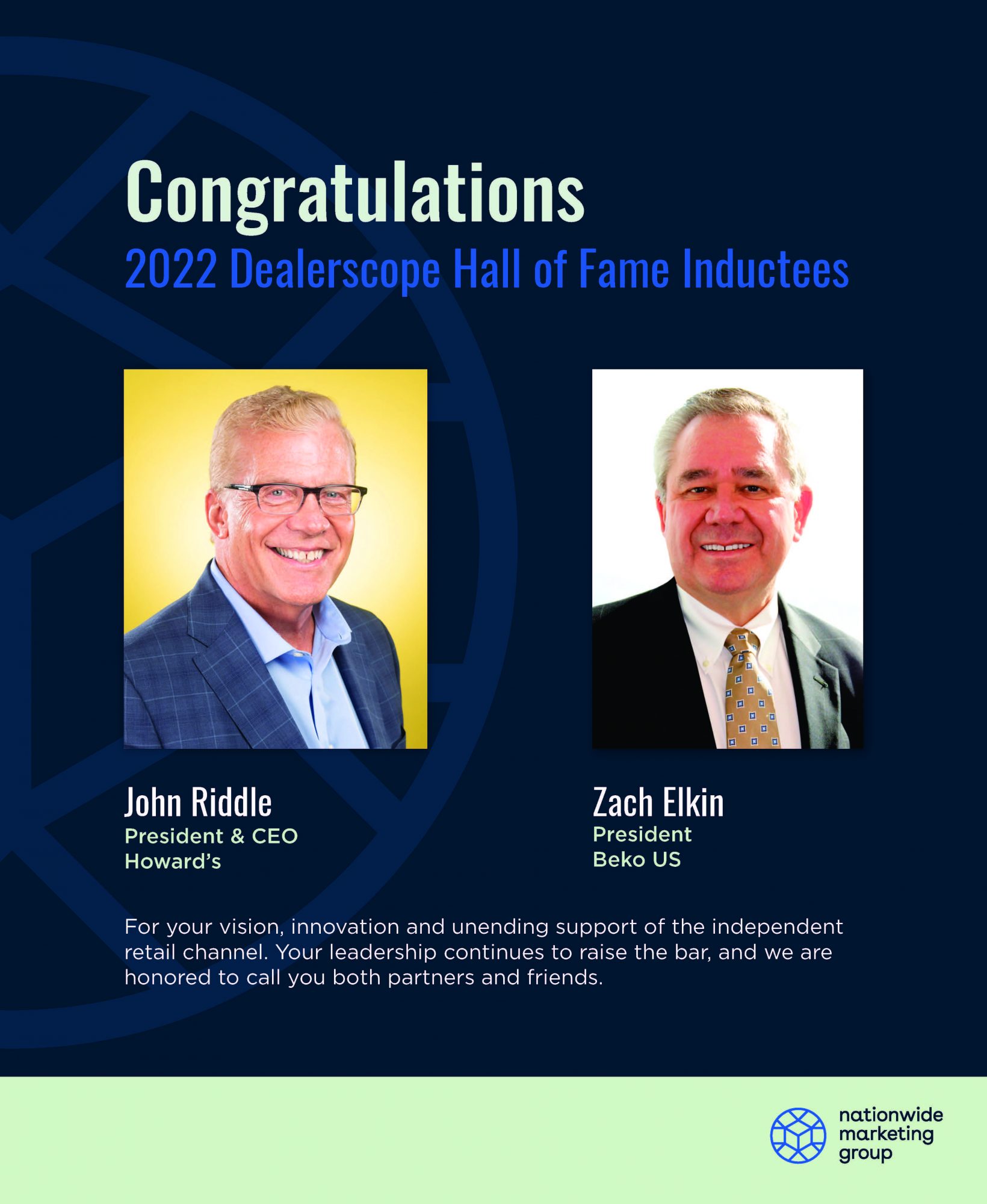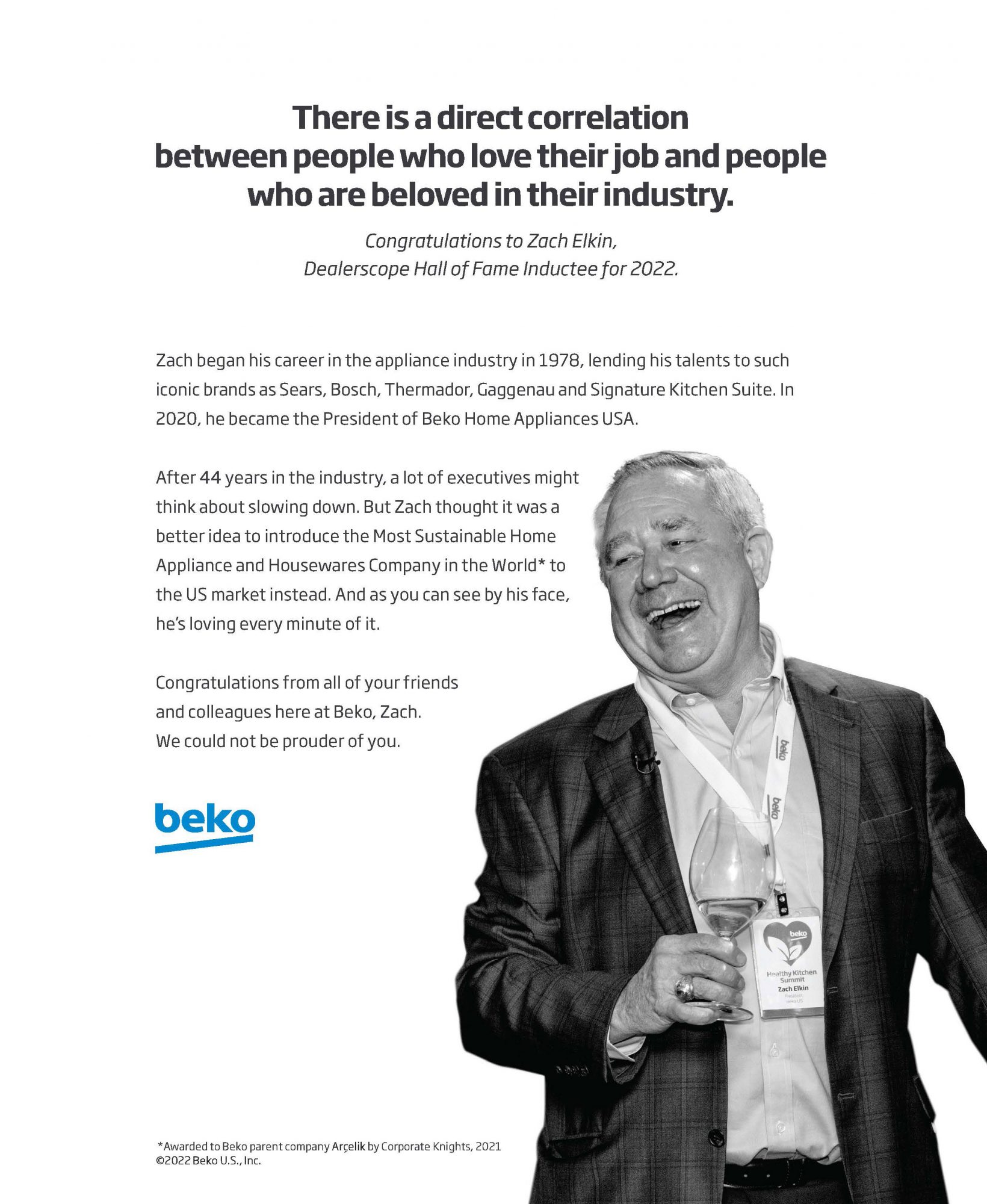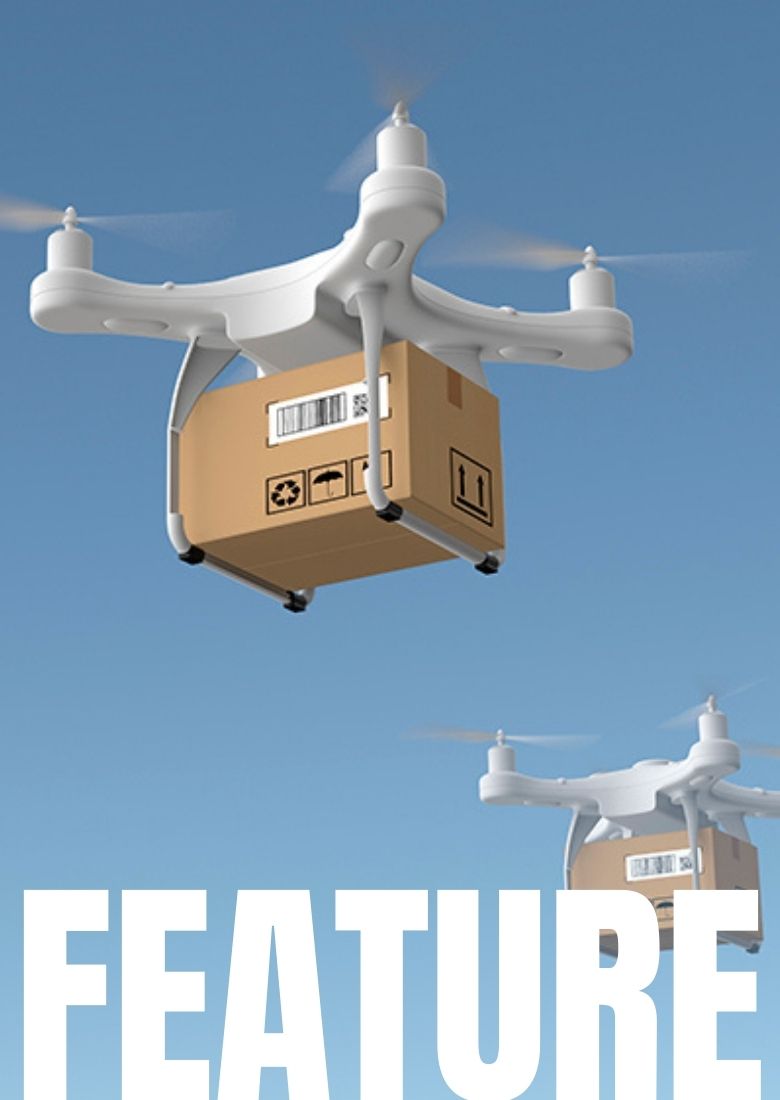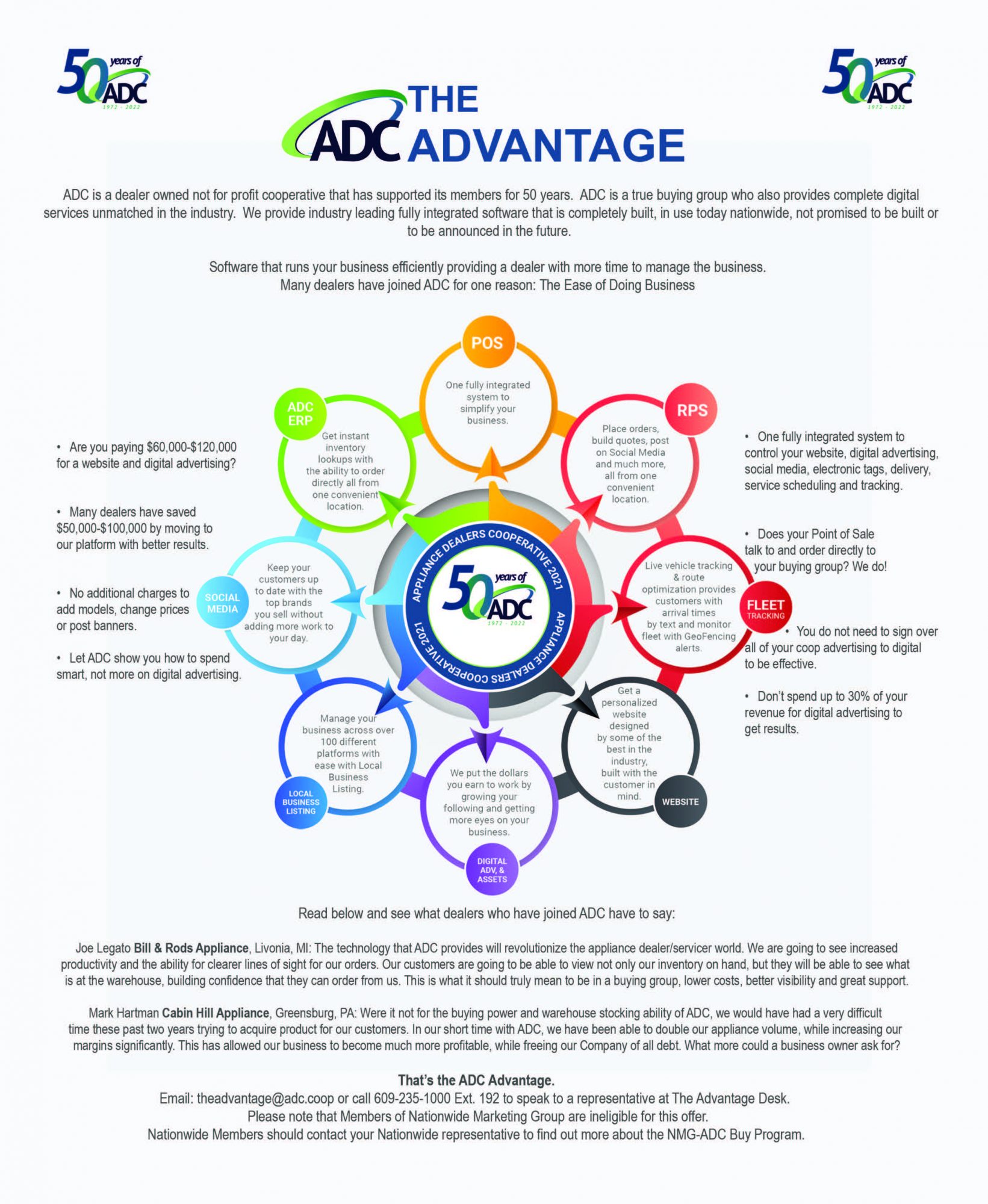This issue’s cover story is devoted to the Dealerscope Hall of Fame 2022, which honors leaders in the consumer technology industry who have performed at an exceptional level for a lengthy stretch of their careers. Read what our five honorees have to say about their management styles, the best advice they’ve received, life lessons, and career highlights. Plus, our annual buying group and distributor roundtable, a preview of 2022 tech to look for, spotlights on Super Bowl TVs, and the ultimate tailgating experience.
CES 2022:
A Look at the
New Normal

Iam excited about what will be an in-person CES this January. I am making appointments and am going to see old friends and partners. And yes, I am looking forward to packing the suits, my portable humidifier, and all my organizational items.
Our January Dealerscope looks at innovators and contributors that have changed our industry. We are honored to add these wonderful people to our Hall of Fame list in 2022. Please check them out in this issue. I personally applaud each of these honorees. We also present dealer and integrator perspectives on Distributors and Buying Groups in our annual roundtable as we head into 2022 and get their take on where product shortages could lead, moving deeper into the new year.
Please make sure to look in our pages for coverage of categories that will resonate at CES 2022. We highlight Food Technology, and Health & Wellness. We give readers an assessment of Bowflex’s hand weights, and we unbox the Fieldsheer Heated Jacket. We also offer glimpses of the best TVs with which customers can view “the big game” — and much more.
Want to know what an NFT is? Look inside for an explanation — and for why you need to know this. We also take a moment to present the “Ultimate Tailgate” showcasing two of the NFL’s prestige teams, as a converted U-Haul gets a makeover that provides the best in infotainment.
And, on the first day of CES, we will be announcing the winners of the 2022 IMPACT Awards. These are our picks of the products destined to make a mark in the new year. We will do an email release of the picks, and then feature the winners in our February issue. Make sure to go to Dealerscope.com to sign up for our print/digital issues and newsletters, to make sure you don’t experience FOMO.
I look forward to a great CES and wish you all the best in Vegas. As always, you can reach me at tmonteleone@ctlab.media.
Best always,
Tony Monteleone,
Group Publisher of CT Lab Global Media
A WORD FROM OUR EDITOR IN CHIEF
Putting Down
the Phone in 2022

It’s mid-December as I write this, but as we are already working on the January issue, we’re thinking about 2022. That means we’re already thinking about New Year’s resolutions. Given that technology is such a part of everyone’s day-to-day these days – not to mention an integral part of this job – it’s not that hard to come up with a list of resolutions specifically around consumer tech. I planned to put down a half-dozen or so of these, but then just couldn’t stop thinking and strategizing about one in particular: Getting my smartphone usage under control.
Though for many years I loved my share of Motorola Razrs, T-Mobile Sidekicks, Nokia N95s, and BlackBerrys, I’ve been an evangelist for smartphones and apps ever since waiting in line for the very first iPhone in 2007. Until recently, I jumped with joy as I tested out each new location-based social media app that launched at SXSW Interactive a decade or so ago. That conference was a hothouse for trying out beta versions of new social media apps, and I still remember laughing the first time that a work colleague stopped in the middle of a conversation we were having to update a post on his phone. (Little did I know that this behavior would soon become the norm.) I was all in on personalization, face recognition, and notifications, to name just a few mobile-era innovations.
However, like many screen-fatigued people these days, I am finding that the last half-decade of algorithmically targeted ads, posts, and updates, not to mention all-too-easy access to bottomless screen refreshes, has taken a toll on my productivity, moods, attention, manners, and sleep. Just like my lifelong efforts to meditate every morning or get to the gym daily, setting consistent boundaries around smartphone usage remains a challenge. I know there are many books, articles, and strategies out there on doing this, everything from weekly digital fasts to putting your phone in another room before going to bed. One approach I plan to try next year comes from brain and memory coach Jim Kwik (jimkwik.com), who has authored several books on productivity and hosts the weekly KwikBrain podcast. Essentially, Kwik’s strategy is to simply not touch your phone for the first hour of the day.
“When you first wake up, your brain is open,” Kwik said when I spoke to him at a pre-pandemic Worldz Conference in 2019. “[Turning on your phone] retrains your brain to be distracted. You are training distraction muscles as opposed to focus muscles. You are also retraining your brain to reacting, and you can’t build a quality life if you are reacting to things.” His words have often stuck with me when I all-too-often reach for my phone as soon as I wake up to check my email.
Instead of grabbing your phone first thing every morning, Kwik suggests the following routine: As soon as you wake up, write three things you want to accomplish personally and three things you want to accomplish professionally. Then, don’t touch your phone until you finish at least one of those things from each list. “The first hour of the day is the most creative for most people,” he said. “You want to limit the input, because the focus is output.”
It’s a neat strategy that I plan to try in 2022, not just to be more productive, but also to be more creative and generate great new ideas in the New Year. After all, new ideas are what the technology business is all about.

Tom Samiljan

CE RETAIL TECHNOLOGY
January 2022 CE News

Shoppers Overstocked This Holiday Season | Did you have too many presents under the tree this past Christmas? One in five shoppers ordered more gifts than needed during the 2021 holiday season, according to research from Oracle. The reason may be that 45 percent of shoppers began preparing for the holidays as early as October, per McKinsey.
National Theft Spree Threatens Retailers | Retailers nationwide have instituted theft-prevention measures such as boarding their windows and keeping important products in lockboxes in response to a slew of high-profile “flash mob” robberies, including at three suburban Minneapolis Best Buy locations over Thanksgiving weekend, that have spread across the country. Concern among retailers is growing as these thefts have become more brazen and violent in recent months.


FTC Conducting Investigation into Supply-Chain Issues | The Federal Trade Commission has issued orders to Walmart, Amazon, Kroger, and other large retailers to submit information that may shed some light on what is causing disruptions in the supply chain by Jan. 14, 2022. The FTC hopes to understand the root causes behind these supply-chain issues, which have caused challenges for consumers and retailers alike.
Looking Ahead to Winter PrimeTime 2022 | Nationwide Marketing Group has announced that it will continue to focus on the Shopper Decision Journey at its upcoming Winter PrimeTime event on Feb. 5-8, 2022 in Phoenix. The event will feature a plethora of buying, educating, and networking opportunities ranging from a 90-minute PrimeTime Palooza shopping frenzy with real-time deals, to more than 100 hours of educational material from the Nationwide Learning Academy.
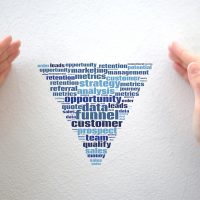

NRF Awarded Stay Against Biden Vaccine Mandate | Absent from President Biden’s most recent restrictions was the mandate for companies with more than 100 employees to fully vaccinate their workforces or implement weekly testing. This requirement was blocked after the National Retail Federation challenged the mandate’s legality in the Fifth Circuit Court of Appeals and was granted a stay. Meanwhile, New York City Mayor Bill de Blasio announced that the Big Apple would implement a vaccine mandate for private companies starting Dec. 14.
APPLIANCES
Kitchen and FoodTech at CES:
What to watch for
A new exhibit at the show offers innovation ranging
from kitchen appliances to smart utensils.
BY ERINN LOUCKS
On the show floor at the Venetian will be an exhibit new to CES, but not a new face in the world of technology and innovation. Introducing the Food Tech Exhibit, which will showcase the latest innovations and new products in kitchen and food tech at CES 2022, happening Jan. 5-8 in Las Vegas. Alongside the exhibit will also be the CES Food Tech Conference, presented by online food publication The Spoon; the partner conference will bring together chef entrepreneurs, appliance vendors, delivery, and food retail inventors.
Both the Food Tech Exhibit and Food Tech conference will not only feature returning exhibitors like Impossible Foods and John Deere, but also introduce groundbreaking products that may soon disrupt the kitchens of the future. Here’s a brief look at some of the niftier next-generation food tech that will be on display at CES 2022.
SpoonTEK
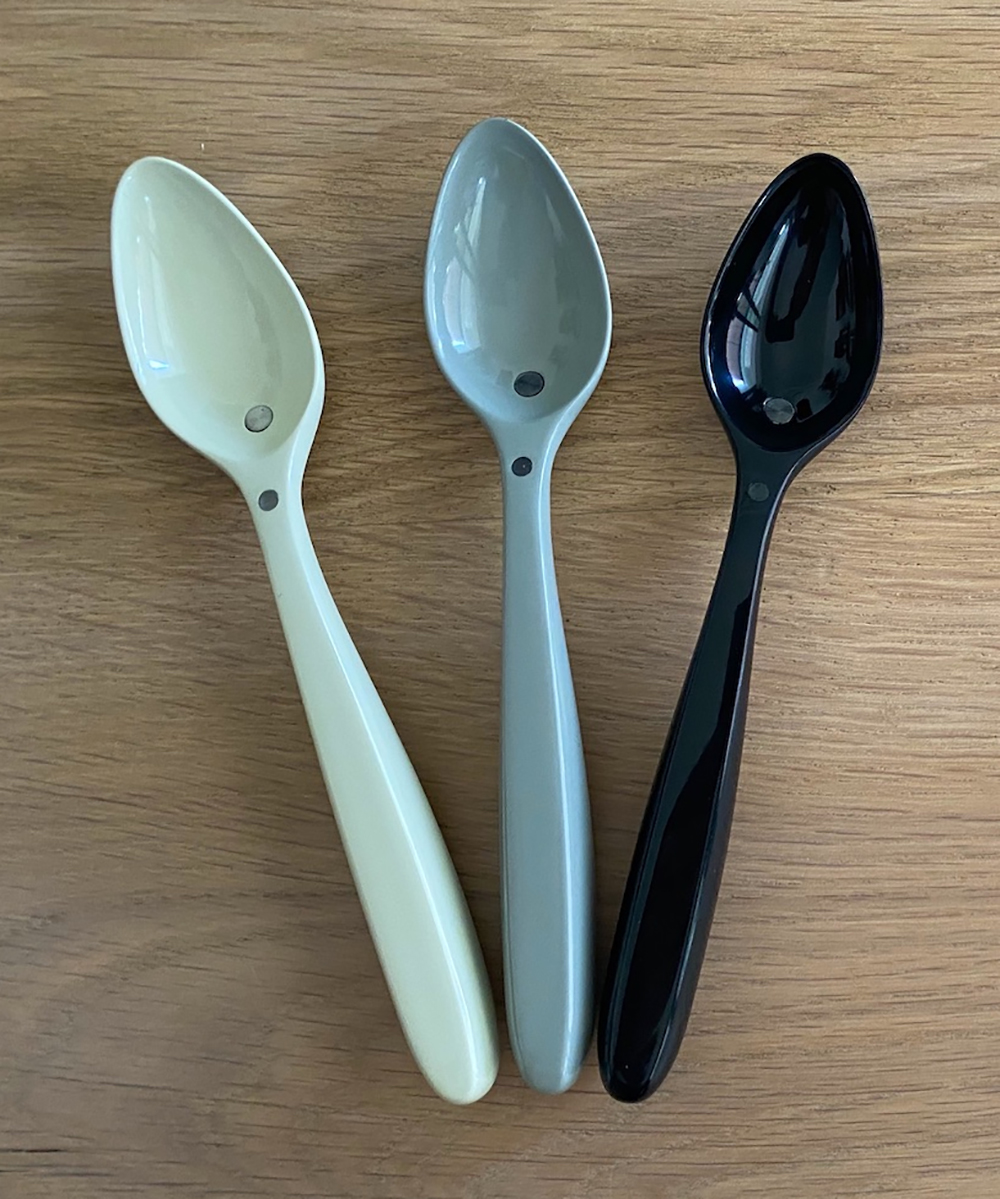
SpoonTEK is the world’s first commercial eating utensil, with built-in electronics to enhance taste and neutralize aftertaste. To do this, SpoonTEK generates a mild electric current that passes through food as it’s eaten. This instantaneous process excites the taste receptors on the tongue’s taste buds to heighten flavor and knock out any sour aftertaste. SpoonTEK is recommended for enhancing yogurt, soup, ice cream, and any products with reduced salt or sugar.
The BRU Maker
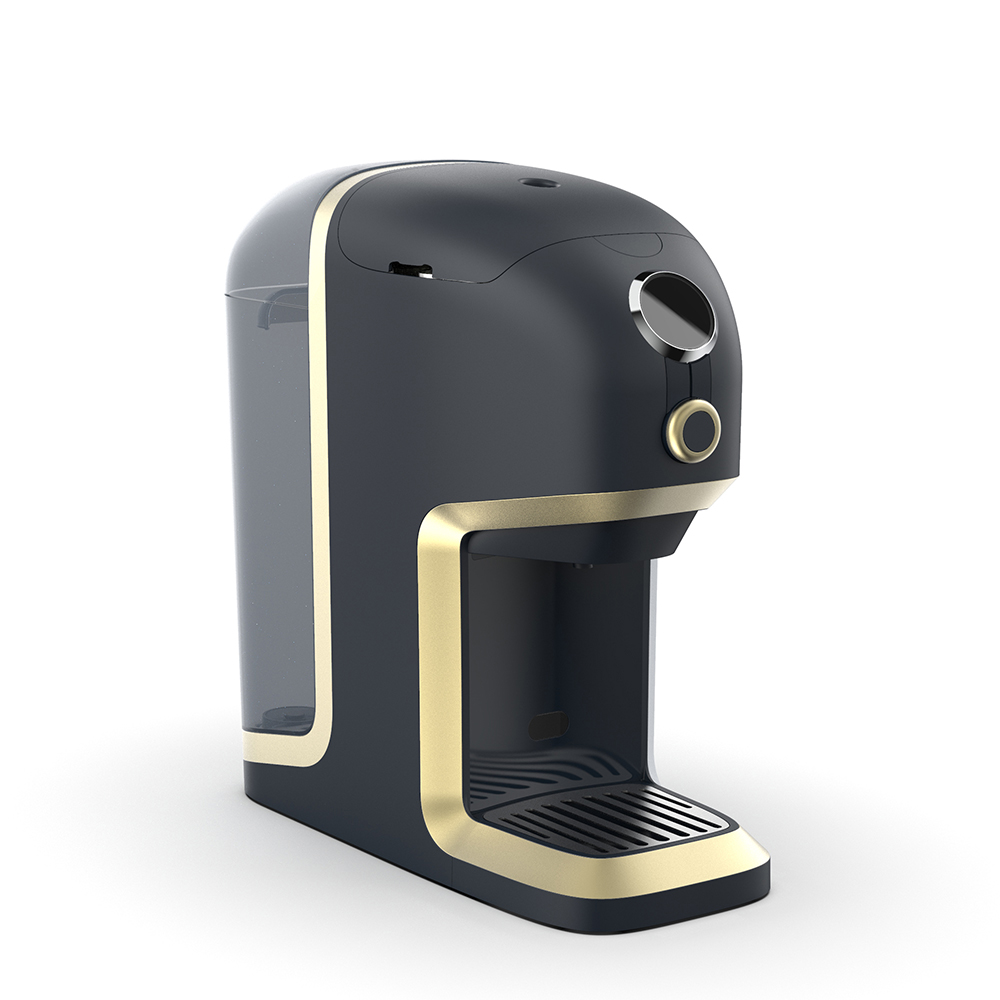
The BRU Maker offers consumers an automated, smart, and user-friendly solution for making fresh tea by using loose-leaf tea or a teabag. The BRU machine is currently the only tea maker on the market that works with both formats, and combines the traditional steeping process with a new and patented technology to make consistently fresh tea at the push of a button. It only heats the water needed for the desired cup size, making it a more environmentally friendly option than boiling a kettle.
The Moen Smart Faucet

The Moen Smart Faucet with Motion Control features a newly enhanced hands-free sensor offering advanced touchless capabilities. With simple hand motions, users can select hot, cold, or warm water and adjust water flow – without ever touching the faucet, which helps reduce the spread of dirt and germs. It also features voice activation, and users can program presets for common commands and request exact temperatures and measurements of water. Since the faucet is a completely touchless experience, it also comes in handle-less styles for a more minimalist look.
Heatbox
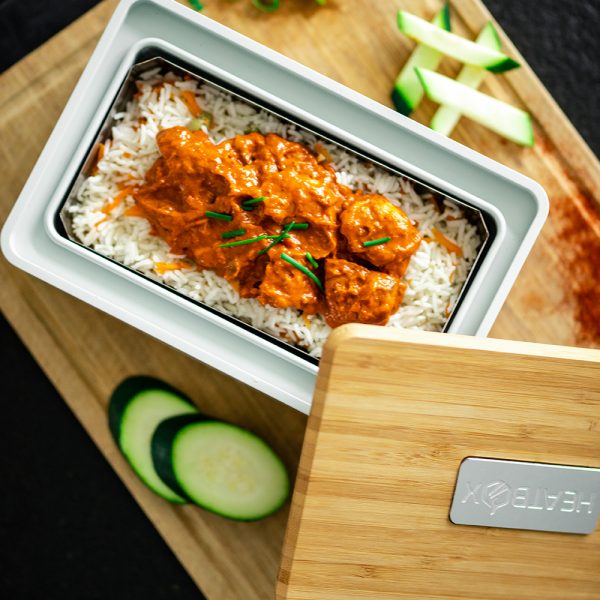
Heatbox is the first self-heating lunch box to use steam innovation and smart technology. Heatbox is app-connected and controllable; through the app, the user can follow recipes and track calorie intake, and they can also connect to and start specific steaming programs. Through its innovative technology, the Heatbox rechargeable system can heat three meals on a single charge.
The Suvie Kitchen Robot
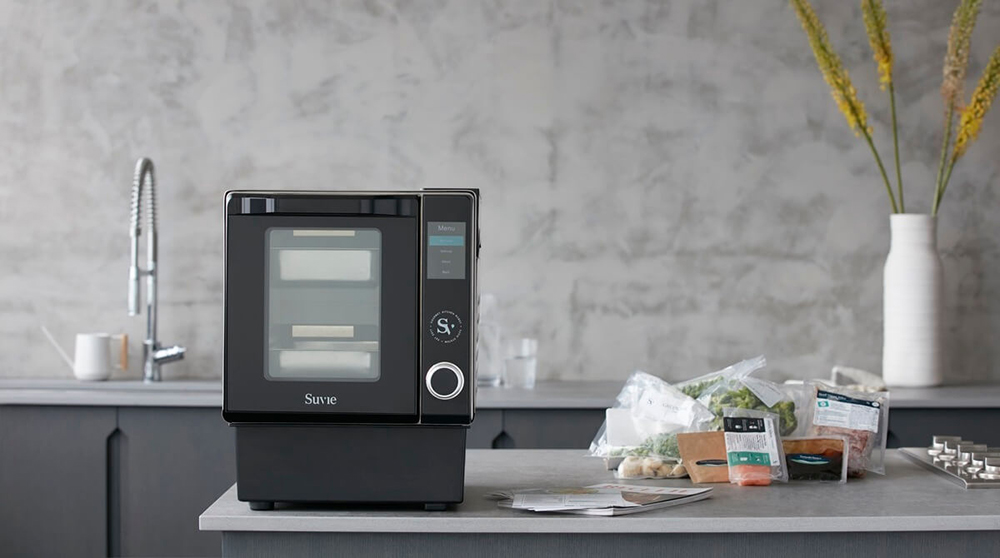
The Suvie Kitchen Robot is a dual-zone, cool-to-cook countertop appliance for proteins, vegetables, and some starches. Users just need to load a meal and tell Suvie when they want it ready, and the robot automatically refrigerates the food and starts cooking whenever is necessary to make that mealtime. Schedule-ahead cool-to-cook works with sous vide, slow cook, reheat, and steam modes. When it’s time to cook, Suvie uses precise temperature control to perfectly cook meats with no risk of overcooking and simultaneously gently steams vegetables. When food is ready to eat, Suvie’s powerful broiling elements heat up to add a final sear to meats or to quickly roast vegetables.

FEATURE TVs
Super Bowl TVs
Today’s sets bring the big game to life
for any kind of viewer and space.
By EGON SANDERS
While Black Friday and Cyber Monday rightly get lots of hype for the home appliance deals on offer, it’s a couple of months later that many choose to invest in a new television. There’s a reason for this: Super Bowl Sunday is the biggest TV event of the year, and retailers typically lean into this fact by heavily discounting televisions in the weeks leading up to the game. The early-January timing of the Consumer Electronics Show (CES) — the annual tech trade show, where TV manufacturers announce their latest models — also helps matters for consumers, as retailers will often discount older TV models in order to sell off existing inventory. As Consumer Reports details, the second best time of the year to buy a television set — just behind Black Friday — is precisely two weeks before the Super Bowl.
And although screen size certainly matters in choosing a new set, there’s more to the picture than just inches. Viewing angles, motion handling, and of course picture quality are all important considerations for picking the right TV for watching the big game. The best sets for sports offer features that prevent things like banding, blur, and smearing when there’s lots of movement on-screen, and let people positioned anywhere in the room see a crisp, bright image. They of course also look great, with lots of detail, contrast, and sharpness — including text rendering, for the older folks in the room.
We’ve gone ahead and picked some of the best sets around for watching this annual mega-event—and for viewing sports, more generally—from five of the market segment’s top manufacturers. (Snacks and beverages are also important, but that’s for another roundup.)
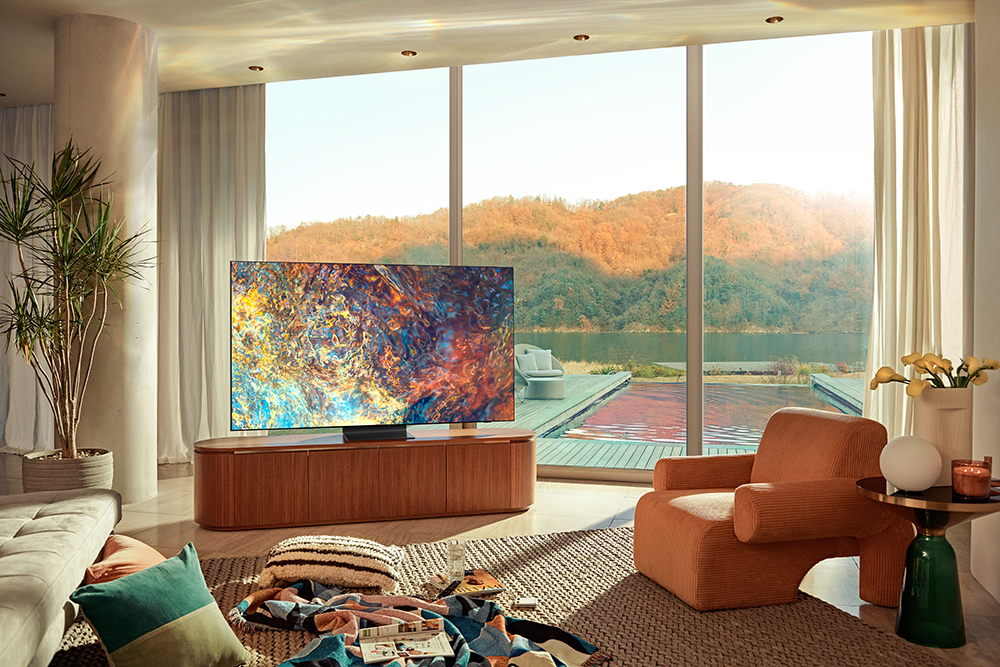
Samsung QN900A Neo QLED 8K TV
If televisions are works of art, the QN900A belongs in a museum. Its bezel is vanishingly thin — less than a millimeter, in fact — meaning the image extends to every bit of the screen. It boasts a remarkable 8K resolution; while you won’t find the game broadcast in 8K (or even 4K, for that matter), the built-in upscaler will help get it looking very sharp, thanks to Samsung’s AI-based ‘Neo Quantum Processor 8K’ technology. Contrast on this QLED screen comes remarkably close to its OLED counterparts, and overall brightness even bests them. Motion is consistently smooth and artifact-free, making on-field action as legible as possible. With 10 (!) speakers built into its ultra-slim frame, the sounds of the game will come in loud and clear as well. For those looking to throw down some cash on a serious set that’s future-proofed for many, many big games to come, this one’s tough to beat.
75-inch — $4,999
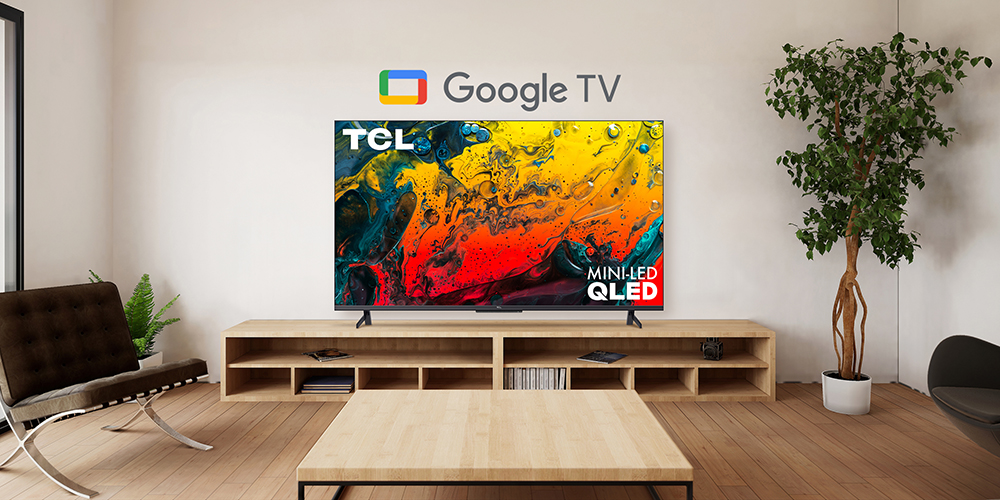
TCL 6 Series 4K QLED Dolby Vision HDR Smart Google TV
TCL’s 6 series of televisions has been a popular choice for a number of years now, and the latest version definitely keeps the hot streak going. Featuring a high-performance QLED ‘Quantum Dot’ display that boasts over a billion colors, TCL’s AiPQ Engine uses machine learning to control color and clarity, doing a great job upscaling regular HD broadcasts to 4K (or close to it, anyway). Dolby Vision HDR helps to clarify every pixel, so you’ll see fine-grain details of the game from every inch of the 65-inch screen. (It’s also available in 55- and 75-inch options.) The mini-LED backlight QLED screen boasts even brightness and contrast for a consistent image from corner to corner, and hands-free voice control lets viewers use the “Hey Google” command rather than scramble for the remote (it also works with Alexa, if you ask nicely).
65-inch — $1,299.99

Sony Bravia XR A80J
For those keeping score at home, OLED is widely considered the king of modern screen technologies. Sony’s A80J uses OLED, which means that each and every pixel of the television can be controlled on an individual basis, or turned off entirely, resulting in deep blacks and amazing contrast. To boot, Sony has some of the best image processing in the business, all but eliminating the kinds of blocky artifacts produced by some displays. Viewing angles are great, with the image staying accurate and detailed from almost any angle — great for accommodating wide seating arrangements, as game parties often must. As one might expect from a high-end Sony display, the A8oJ is remarkably thin with a virtually nonexistent bezel, making it quite a looker. The system is powered by Google TV, and performs better than any Sony set before it.
65-inch — $2,299.99
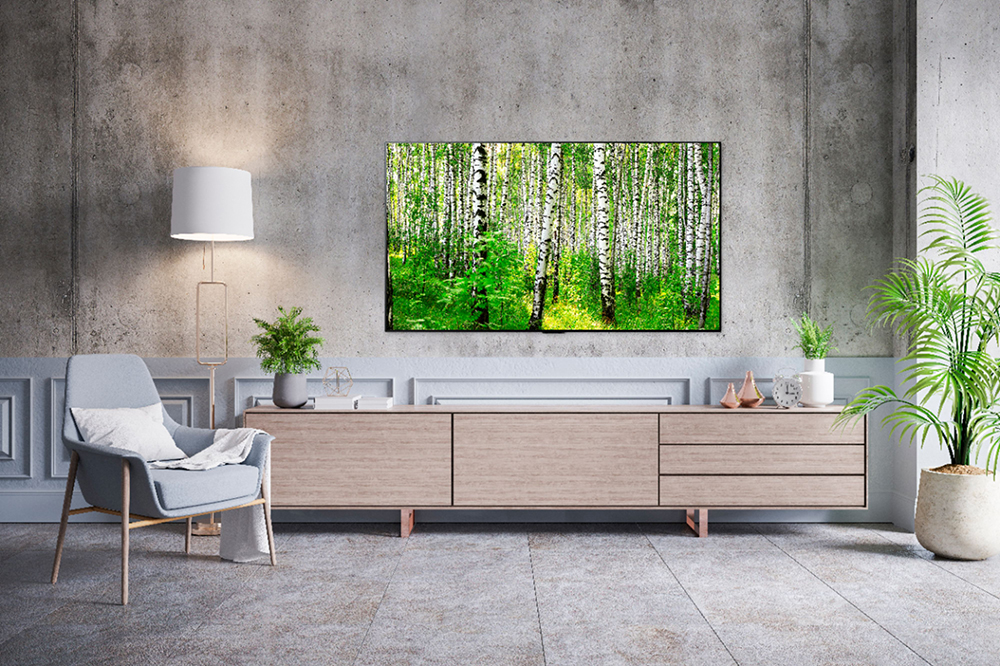
LG G1 OLED
LG’s G1 is one of the most impressive consumer OLED sets on the market, boasting deep black levels and remarkably punchy and detailed picture quality. At just 0.8 inches deep, the LG G1 is ultra-slim and flat, with no protruding bits getting in the way of its ideal home: mounted on your wall. (It really was made for mounting — in fact, owners will need to buy side legs for about $100 if they want it to sit on an entertainment stand or table.) Being able to easily mount it higher up on a wall is a game-changer for viewability in a crowded room, and the low profile, museum-quality design and slip bezel make it really blend into the room (as much as a massive 65-inch screen can, anyway). Motion handling on the G1 is also state of the art, with deep customization options for those who want it to smooth out motion without artifacting or jitter, and viewing angles will let everyone catch the action, no matter where they are in the room (unless they’re face down after too many beers, that is).
65-inch — $2,999

Hisense U9DG
In the war between various screen technologies, Hisense has taken a somewhat different tack than most for its flagship TV. The U9DG uses what the company calls “dual cell” tech, whereby it essentially layers two LCDs on top of each other over an LED array. The resulting output hits near-OLED contrast levels, with improved brightness and a detailed image that can compete with most of the best screens out there. It looks good from a wide range of viewing angles and sports top-notch reflection handling, without any of the sort of rainbow smearing often found with anti-reflective screen coatings. The U9DG does 4K at 120Hz, and its Ambient Light Sensor+ automatically detects the lighting conditions throughout the day to adjust the backlight and enhance the image onscreen accordingly. For those trying to ensure the game party happens at their place, this set will certainly help the case.
75-inch— $3,499.99

AUDIO/VIDEO
Lions and Tailgates and Bears:
Oh My!
Converted U-Haul gets a game-day makeover.
Football fandom is a community. Cheering a team on together can bond a family closer and create instant connections among total strangers. Father and son Frank and John Bubeck have been Chicago Bears season ticket holders for years. It’s their tradition to rise before the sun on game day, arriving at Soldier Field the moment the parking lot opens to commune with fellow fans and squeeze the absolute most out of each Sunday. Over the years, they’ve seen more and more elaborate setups populate that lot. Football may be a community, but it’s also a competition. Five years ago, the Bubecks reached out to automotive specialist Soundz Plus to help them win at tailgating.
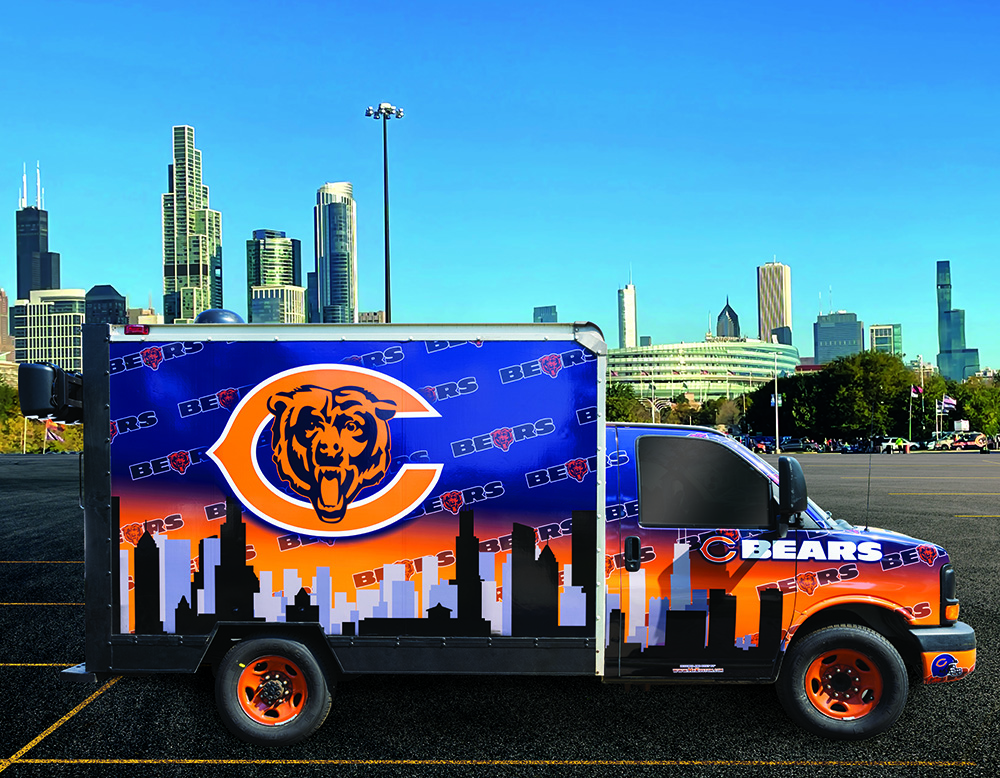
Soundz Plus excels in creating one-of-a-kind custom vehicles. They work on everything from supercars to old-school Detroit iron, transforming the vehicles into sophisticated media centers, exposition showpieces, and once, even a DJ booth. “That was an interesting one,” says a grinning Brian Ganz, Soundz Plus’s owner. “We sawed a Cadillac in half and took out the engine. It was a classic, but the customer knew exactly what he wanted.”
For this project, Ganz and the Soundz Plus team transformed a very different kind of classic: the iconic U-Haul cube truck. The refurbished truck screams “BEARS” from every angle. To create “DA BEARS” truck for the Bubecks, Ganz applied a custom exterior Chicago Bears wrap and fitted the cargo area with color-matched built-in benches. This truck was made for the whole Bears community, decked out with speakers and screens on the back doors for game-day barbecues. The Soundz Plus team also added a full AV system inside the cube so that the party could continue, even as winter sets in.
Ganz is a committed Detroit Lions fan. It’s therefore become one of the greatest ironies of his career that he has spent several of the last five summers working on an iconic Chicago Bears tailgating experience. This project has seen several updates since it first debuted; this year, Ganz worked with Vanco International to completely overhaul the truck’s sound systems.

Beale Street Audio – 8’ In-Room Subwoofer
The project’s goal was improve the quality of the sound system overall, while also offering comfort and control for listeners in two very different environments: the close confines of the cargo cube, and the wide-open spaces of the Soldier Field parking lot. Clearly, a zoned solution (housed in a relatively small physical space) was required.
The use case of the truck introduced a couple of additional considerations. DA BEARS is no expo showpiece, surrounded by security and designed for appearance rather than function. It’s in constant use, both at games and family events like birthdays and holidays. On game day, everything must fold neatly and quickly inside the truck so that all the top-of-the-line AV equipment is secure while the Bubecks are inside the stadium. Ganz also had to be very mindful of the system’s power budget, since all the equipment must run off of a single portable generator.
With this latest update, Soundz Plus upgraded the generator and used Vanco’s Beale Street Audio line to achieve superior results within these constraints. “This was my first time working with Beale Street Audio,” says Ganz. “Those Beale speakers are powerful. I was pleasantly surprised by the amount of oomph they pack into their form factor.”


Beale Street Audio – 1000W 4 Channel Amplifier
The new system consists of two audio zones, with separate control for the interior and exterior of the truck. Beale Street’s patented Sonic Vortex technology, which eliminates sound bleed between adjacent spaces, makes it possible to have two distinct zones in such close proximity. That was crucial for this project. Per Ganz: “As much as we want the sound system to have a major impact in the parking lot, we want those inside the truck to have a great experience, too. This new zoned system gives us immersive sound without overwhelming the tight interior space.”
DA BEARS’ sound experience now includes six Beale Street two-way 4” in-wall speakers, an 8” Beale Street Subwoofer, and two 1000W 4-channel amplifiers. The new equipment necessitated custom-fabricated enclosures and housings – all in classic Bears orange, of course. Such extra details take time and attention, but it’s worth it to create such an immersive tailgating environment.
Ganz takes great pride in continuously improving the DA BEARS experience. Though he never forgets where his own loyalties lie, the football community extends beyond any one team. “I may be a Lions fan, but I love football. I wanted this truck to look and sound good — and our client is thrilled with the final results.”

UNBOXED
Body Heating
The Fieldsheer Adventure Heated Jacket offers adjustable temperatures for increasingly colder climates.
BY SAM HITT
When my editor asked me to review the Fieldsheer Adventure Heated Jacket, my first thought was: What could go wrong by walking around with an electric heater attached to my chest? Would wearing the jacket in the rain somehow turn me into a piece of human bacon? Obviously, the engineers of this jacket had the foresight to create a product that wouldn’t accidentally electrocute the user, and, in truth, the Fieldsheer Adventure Heated Jacket is an amazing example of tech’s expansion into non-traditional industries.
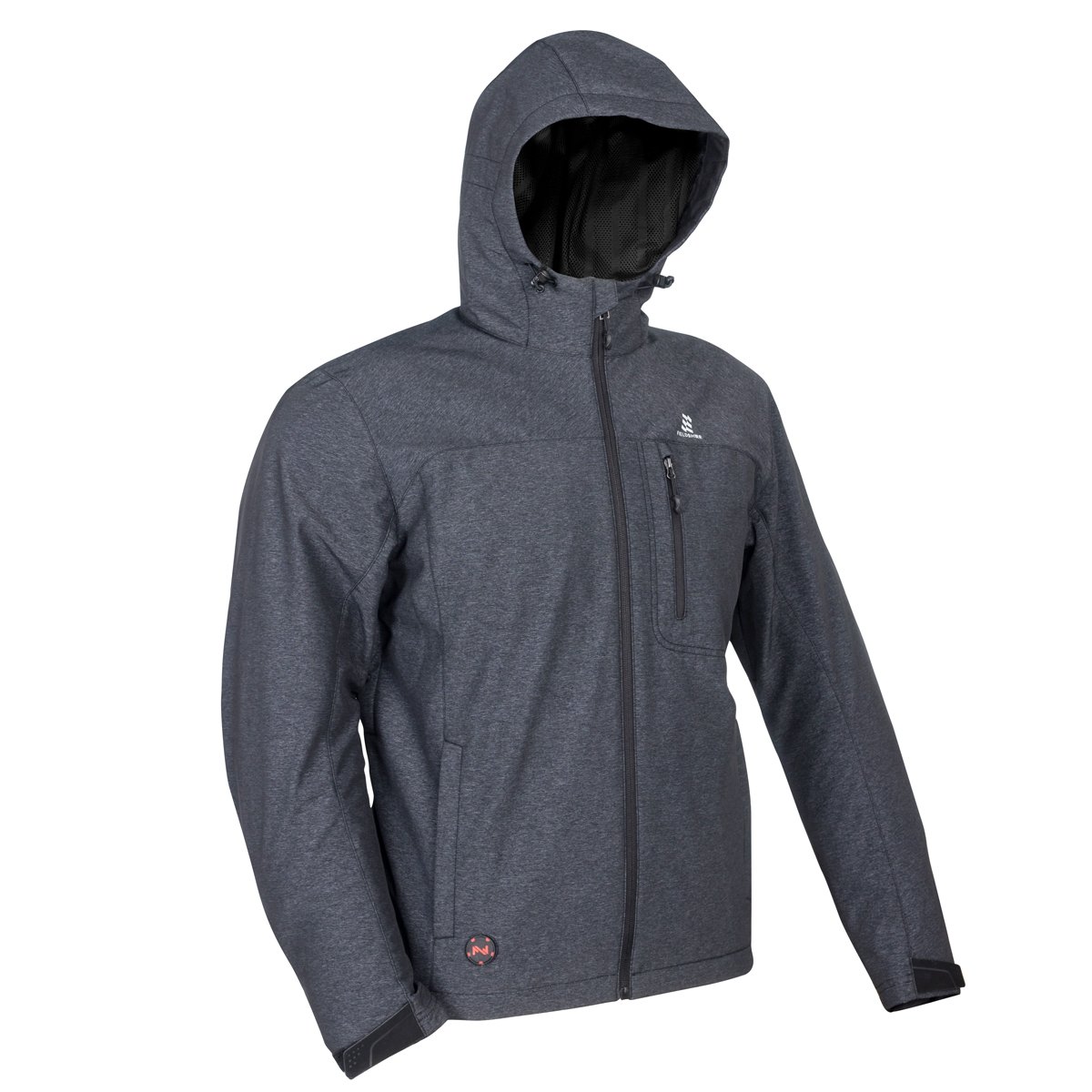
Unboxing
Upon unboxing, I was amazed by the discreetness of the heating coils. The material of the jacket retains all the flexibility of a traditional article of clothing, and if I hadn’t known better, I wouldn’t have suspected that there was anything special about it. The Fieldsheer Adventure Heated Jacket comes with an instruction manual, the Powersheer™ XL Rechargeable Lithium-Ion Battery, and a USB-C charging cable. The battery itself is the size of a large smartphone and doesn’t come charged, which was a slight nuisance as it takes about four to five hours to get fully topped off. Moreover, getting the jacket fired up is not completely intuitive. To turn the jacket on, the user has to take the battery out of the sleeve in the right-hand jacket pocket; activate it, and then put it back in the sleeve. This process needs to be repeated after any period of extended inactivity.
Setup
The Fieldsheer Adventure Heated Jacket includes four different levels of heating: 135-, 120-, 105-, and 90-degrees Fahrenheit. The user can toggle among these different levels of heating remotely by using the MW Connect mobile app or manually by using the built-in waterproof touch control button on the bottom right-hand corner of the jacket. When wearing the jacket, it can be challenging to tell what level of heating you are on by feel alone. Luckily, when in use, the touch control button lights up with a unique color that corresponds to each heating level. At full strength, the 7.4-volt battery can operate at the warmest setting for a little over three hours and at the lowest setting for a prolonged period of 13 hours. Available on the App Store or Google Play Store, the MW Connect mobile app links up to your mobile warming garment via Bluetooth, allowing the user to control the jacket from their phone. Via the mobile app, users can adjust heating levels, receive real-time information on the jacket’s battery level, and update the garment when new firmware is released.
Wearing and Using
Now to the fun stuff. Let’s get into the tech that goes into the Fieldsheer Adventure Heated Jacket. The heating pads within the jacket comprise ultra-fine fiber elements that harness the energy within the battery. These fibers are pressed up against a conductive heating panel that faces towards the body and a reflective heating panel to the exterior to make sure that the most heat possible is projected onto the user. These ultra-fine fibers are also what make the heating pads in the jacket almost entirely unnoticeable. The exterior of the Fieldsheer Adventure Heated Jacket is coated in polyurethane to create a waterproof shell that allows perspiration to escape. At the same time, the sewn seams of the jacket are sealed with waterproof thermoplastic tape. The jacket’s exterior utilizes a series of membranes that block wind from entering the core of the jacket to help the user preserve body heat. The jacket also features Fieldsheer’s PHOSLITE technology, which utilizes thousands of tiny reflective lenses in the jacket material to reflect light back to the source.
The Pupper Test
I know you all have been waiting to hear about what happened to me when I wore this jacket in the rain. I am sorry to disappoint, but the RAINGAURD technology did its job, and I did not get electrocuted. The Fieldsheer Adventure Heated Jacket is certainly built to withstand the cold, which is a major blessing this time of year, as the nights here on the East Coast begin to get seriously frigid. Though the heating pads are centralized in the chest and back area, they deliver an effect that ripples across the entire upper body, so that when you are wearing the jacket outside, it feels as though you are wrapped in a warm comforter.
This jacket has made both my dog and me extremely happy campers. To her delight, I have been putting this jacket to the test on our nightly walks and trips to the dog park, which has increased the time we spend outside by a solid 30 minutes. She is two years old and is a big jumper with a lot of energy. I am happy to report that the jacket exterior is extremely durable, despite her best efforts to claw it to shreds.
Functionally, this jacket is impressive; however, the light-up LED button on the front of the jacket makes me feel a bit like a glowstick when I walk around at night. That being said, having the color designated light-up button makes it extremely easy to toggle settings when it’s cold outside and you don’t want to whip out your phone.
Takeaway
I thoroughly enjoyed my time with the Fieldsheer Adventure Heated Jacket and plan on retaining it as a daily staple for dog walks, hikes, and the occasional ski trip once the season rolls around. When I use this jacket, I crank it up to the highest setting at 135 degrees Fahrenheit for optimal comfort. Because of this usage trend, I would like to see Fieldsheer develop a battery system that is capable of longer run-times at maximum output, which is currently only three hours.
Takeaway
The Fieldsheer Adventure Heated Jacket (fieldsheer.com) is available in heather gray and sells for $229.99. When selecting a size, keep in mind that these jackets run slightly small.

NFTs
Is That TV NFT-Ready?
What dealers need to know about the crypto art boom.
By DAN MIKESELL, President, Blackdove
The NFT (Non-Fungible Token) is a relatively young technology that has, in the past year, demonstrated its potential, value, appeal, and staying power. The size of the NFT market exploded in 2021. The sharp upward trajectory that began last winter reached $10.7 billion in Q3, compared to $28 million in Q3 of 2020, and shows no sign of slowing. This growth isn’t solely driven by ballooning prices; most NFTs actually cost least than a thousand dollars. The community of NFT buyers is growing — and with it, opportunities for technology dealers.
NFTs have no physical form – how, then, do they represent an opportunity for hardware dealers? It all comes down to how NFTs are being used, and how those use cases are, in turn, altering customer behaviors and shaping future needs. Looking at the past year’s exponential growth and digging into the categories driving it, we can make some pretty reliable predictions about how NFTs will drive future hardware requirements. Dealers should be learning everything they can about this market now in order to service these forthcoming demands.

NFT Basics
First, let’s establish the basics of what an NFT actually is: a blockchain-based digital token. Blockchain technology is one of the most secure forms of digital ownership – a public ledger of transactions that is nigh-immune to hacking or alteration. Currently, most NFTs are based on the Ethereum (ETH) cryptocurrency blockchain, though other cryptocurrencies are beginning to develop NFT support as well; this is why you often see the prices for NFTs listed in ETH.
Unlike fungible cryptocurrencies such as Ethereum or Bitcoin, an NFT is attached to something unique, such as a work of art, a collectible icon, or a video. Fungible items can be traded like for like: if I trade my Bitcoin for your Bitcoin, we both still have a Bitcoin. If I trade my CryptoPunk NFT for your Bored Ape Yacht Club NFT, however, we both end up with something fundamentally different than we started with. That’s what “non-fungible” means.
Because an NFT can be attached to basically any kind of digital file, they’ve always been a fertile ground for experimentation. NFTs have been used to trade sports clips, tweets, and New York Times articles. They’ve granted access to new television shows. Sony and AMC gave them out to advance ticket purchasers for the most recent Spiderman film. All of this variety can make it seem like the NFT market is too difficult to pin down – too much in flux – to plan around. Don’t get distracted by boundary-pushing at the margins, though. The core of the NFT market is and will continue to be visual artwork, both in the form of collectibles (like the aforementioned Bored Apes and CryptoPunks) and in the form of fine art. Together, art and collectibles account for nearly 85% of recent NFT transactions. This is the use case dealers should be thinking about as they look to supply solutions to NFT-owner customers.
Emerging Hardware Needs for NFTs
Once someone buys an NFT, it is stored in a digital wallet, such as Metamask. And… then what? Many NFTs are status symbols online – owners like Jay-Z use them as social media profile pictures, and they act as de facto access cards to exclusive owner communities on platforms like Discord. However, when a customer has made an (often significant) investment in a unique visual artwork, it’s only natural to want to display and enjoy their prize with friends and family in real life as well as online. They need technology solutions to bring their NFT collections out of the cloud and into their home.
In practice, this means that they need a few basic things. First off, they need digital art management software that is capable of integrating with a digital wallet and imports all media files associated with the customer’s NFTs while leaving the NFTs themselves secure in the wallet. Customers also need a display, which may be an existing screen in the customer’s home, used for multiple purposes, or it may be a dedicated display solely for use as a digital art canvas. In addition, there must be a way a way to control their NFT collection, creating playlists and selecting which works will be displayed, as well as when and where. Lastly, if they wish to display their NFTs in more than one location at once, they also need to integrate an art server into their video distribution system.
All that may sound complicated, but it doesn’t have to be. Purpose-built digital art canvases are available from a growing number of manufacturers, and many smart TVs are compatible with digital art apps. Be forewarned, though: not all digital art software can integrate with a digital wallet or support the management of NFTs. When recommending solutions for the display of NFTs, make sure these unique assets are supported end to end.
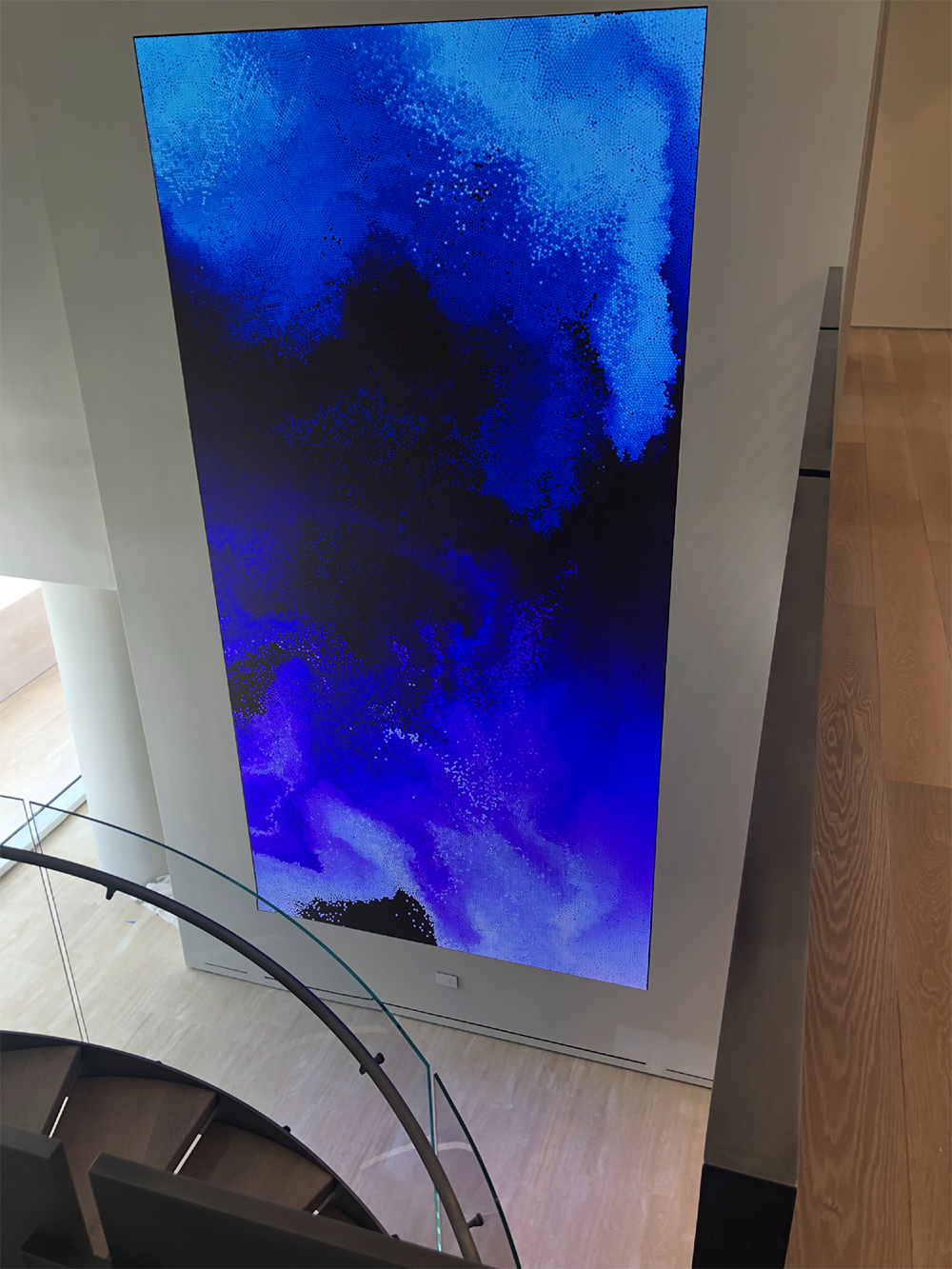
Beyond Crypto: Expect Sustained
Demand for Digital Art
For many individual collectors, purchasing an NFT was the first time they ever considered buying digital art. The experience has opened their minds: Through NFTs, people are beginning to grasp the broader possibilities of displaying and enjoying digital art in their own homes.
“NFTs created a budget for digital art,” says Jess Conatser, contributing curator for Blackdove. “Now, people understand that this kind of artwork – which they once regarded as something you might see only as a public installation or in an immersive gallery or museum – is available for ownership and collection.”
This is new behavior for homeowners and art aficionados, and it will have a lasting impact on the way art is created, sold, and enjoyed. Just as the digital revolution permanently changed the music industry even as early-day sharing sites like Napster and Bearshare fell by the wayside, this shift in perception on digital art will outlast even the current wildfire interest in NFTs themselves.
“Now that the value of digital art has been established in the marketplace, that value doesn’t have to remain tied to NFTs as a sales mechanism,” says Conatser. “NFTs have opened people’s eyes to the value of digital art, but not everything needs to be an NFT to have value. Open editions and limited additions of digital works have an intrinsic value of their own.”
NFTs and the Future of Digital Art
NFTs are revolutionizing the art world. More people are collecting than ever before. More people are incorporating digital art into their homes and lives. The marketplace for NFTs is extremely strong right now, but the broader marketplace for digital art continues to evolve. For dealers, this means that being future-ready requires them to look for flexible technologies. You need solutions that can manage and display any kind of media asset, including NFTs.
You also need a way to stay connected to the art market as it evolves so you can anticipate collectors’ needs. If you’re not personally passionate about art, look for a technology partner who is. At my own company, Blackdove, we offer not just technology services, but art advising and curation services. There will undeniably be an ongoing market for digital art, and an ongoing need to track ownership of digital art as time goes by. Make sure you have the partners, expertise, and technologies lined up to serve this valuable and growing category.
Key Takeaways:
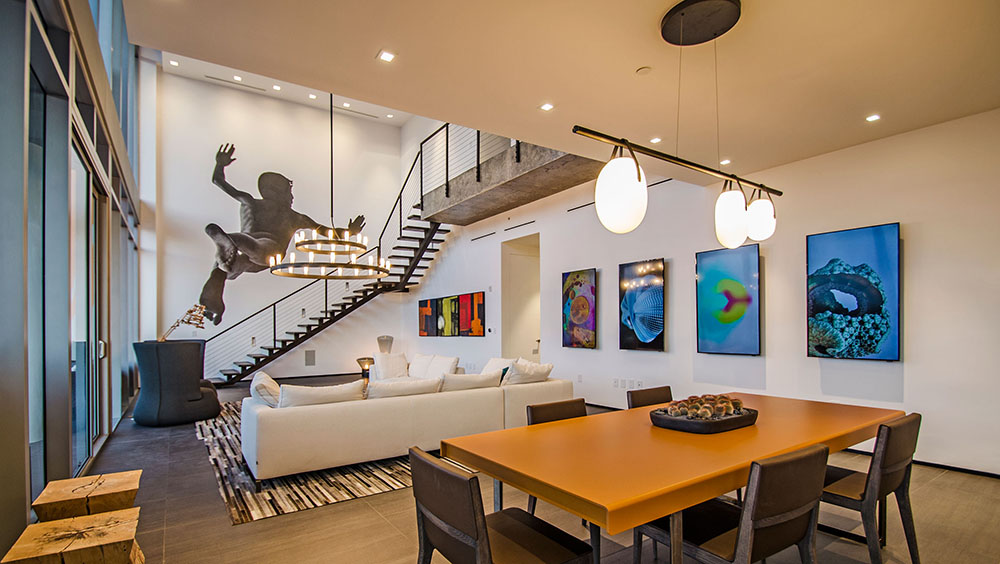
-
The rapid growth of the NFT marketplace will lead to rich opportunities for hardware technology dealers
-
Though NFTs are used in a wide variety of transactions, the most mature and important segment of the market is visual art
-
NFTs have created a new and growing community of individual owners of digital artwork – a technology application that quite likely will outlast even the current NFT boom
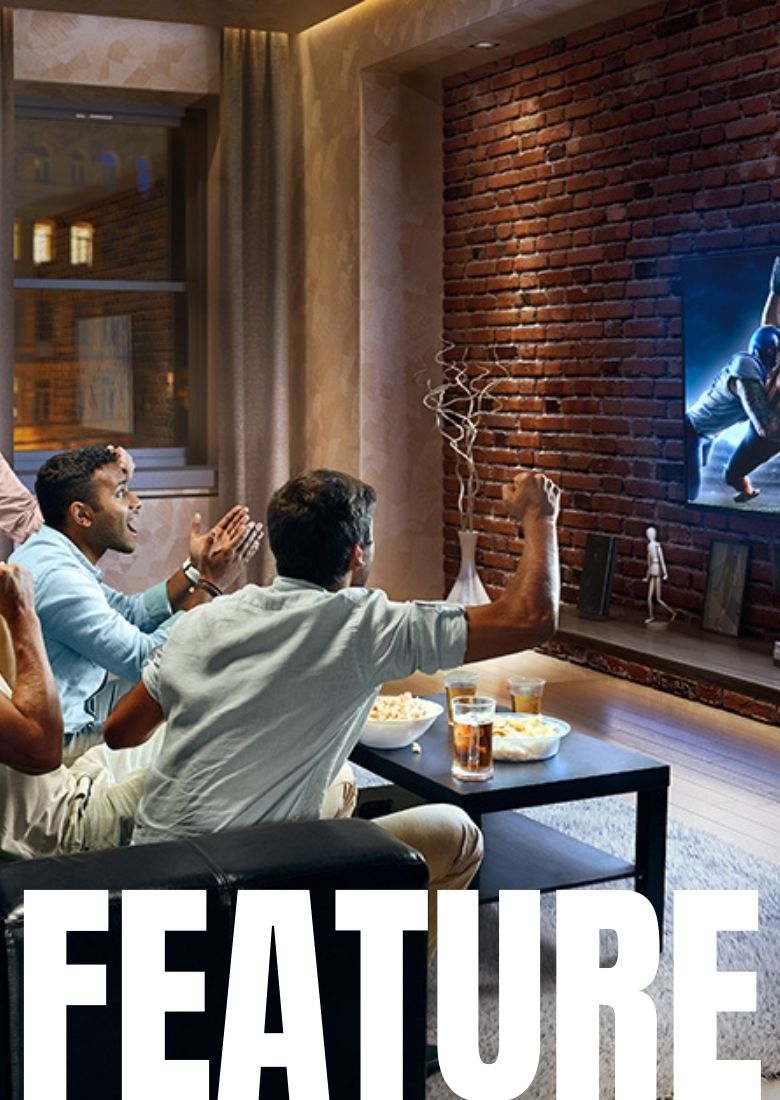
VIDO FEATURE
Flipping Out
Today’s streaming video landscape is fraught
with challenges and continuous churn.
By PAUL ERICKSON, Senior Analyst, Parks Associates

The over-the-top (OTT) streaming video service market is at an all-time high, with consumers benefiting from an abundance of choice from a variety of service providers offering a variety of content and subscription models. For streaming video service providers, the environment is fraught with challenges.
According to Parks Associates’ consumer survey data, the consumption of streaming video services among U.S. households was already accelerating prior to COVID-19, and service adoption continued its ascent during the pandemic. This survey data found that in Q1 of 2021, 82 percent of U.S. broadband households had at least one OTT video subscription, up from 71 percent in Q3 2019.
In the U.S., the percentage of people with an OTT video subscription has surpassed the percentage who subscribe to traditional pay TV. As of Q3 2021, U.S. broadband households now subscribe to an average of 5.6 OTT video services each, according to Parks Associates survey data. OTT video is now the primary way that U.S. consumers access video, and their appetite for content continues to grow. Service stacking has yet to measurably decrease as a result of subscriber fatigue.
As of the first quarter of 2021, nearly half – 46 percent – of U.S. consumers had four or more OTT video subscriptions. In the prior year around that time, it was less than half that, at 22 percent. Eventually, consumers will experience subscription fatigue and start to limit the number of services they will adopt. People have only so many hours and attention they can devote to video. The more services that are competing for pieces of that whole, the harder it is for individual services to be sticky, engaging, and secure in the long term within the service stack.
Subscription lengths and service hopping
The “no-contract model” for OTT services makes it is as easy for consumers to cancel as it is to subscribe. Parks Associates data shows that Netflix dominates the market with an average subscription length of 48 months, but subscription lengths for other video services fall off sharply outside of the top three (Netflix, Amazon Prime Video, and Hulu).
The OTT marketplace is more crowded with the launch of high-profile new services from major studios and conglomerates such as Disney+, HBO Max, and Peacock, and this has made building subscriber loyalty and retention both more difficult and more invaluable.
Video service providers must also contend with subscribers who are especially challenging to retain. Parks Associates research has found that one-quarter of OTT video subscribers are “hoppers” who generally stay with their services for less time, switch services more frequently, have more subscriptions, and cancel more services over a 12-month period compared to other subscribers. Service hoppers are the most demanding subscribers and disproportionately contribute to churn, making them an important retention challenge for today’s video services.

Retention and churn
Retaining subscribers and minimizing subscriber churn are of crucial importance for streaming video services. Parks Associates research shows that OTT services inherently face a higher level of subscriber churn than traditional pay TV services. According to Parks Associates data, the OTT subscriber churn rate in the U.S. as of 2021 is 44 percent.
Content is a primary factor in churn. For services to retain users beyond their initial interaction, regular, relevant, and engaging content is a necessity. Parks Associates research found that 37 percent of subscribers to a new OTT service in the last year indicated that they were planning to terminate their subscription because of a lack of new content. The rise in consumers’ OTT service stacking is indicative of their willingness to intentionally seek out and subscribe to services that provide the content they desire. Stacking, thus, also is a reflection of consumer willingness to churn away from a service, if there is a lack of personally relevant content.
Video services have options available to entice their users. Parks Associates research found that when presented with a list of standard retention options, 21 percent of users referenced the ability to pause a subscription and 21 percent also cited the availability of a lower-priced tier. Given the variety of methods available, and with no single one dominant, the correct selection of retention options to offer an individual subscriber is of high importance in driving successful retention efforts.
With no logistical barrier to consumer churn, services must forge an emotional connection to their subscribers, which is done through a positive combination of content and user experience that drive perceived value.
Video services are seeking ways to optimize the performance of their businesses in as many dimensions as possible. Data, insights, and actions enabled by the application of artificial intelligence (AI) and machine learning (ML) can maximize their abilities to compete and thrive in the current high-pressure streaming video landscape.
This article is an excerpt from the Parks Associates white paper, AI-enabled Data: Key to Video Service Optimization, published in partnership with SymphonyMediaAI.
For more information, please visit www.parksassociates.com

HALL OF FAME 2022
Making a Difference
Meet the Dealerscope Hall of Fame Class of 2022.
STORY CONTRIBUTORS:
Tom Samiljan, Stephen Silver
The Dealerscope 2022 Hall of Fame honors five leaders who have consistently excelled throughout their illustrious careers in the appliance, consumer technology, and retail sectors. They have each made a significant impact on everything from branding to product features to corporate culture. Thanks to them, some of the today’s marquee appliance and consumer electronics brands are household names packed with cutting-edge features that consumers want. Thanks to them, product quality and usability has improved every year. Their passion, commitment, and consistency are qualities we can all admire and aspire to. In the following pages, we asked each of them a series of questions. Read on to hear what they have to say about the evolution of technology, their management styles, top advice, and the future of our business in the next few years.
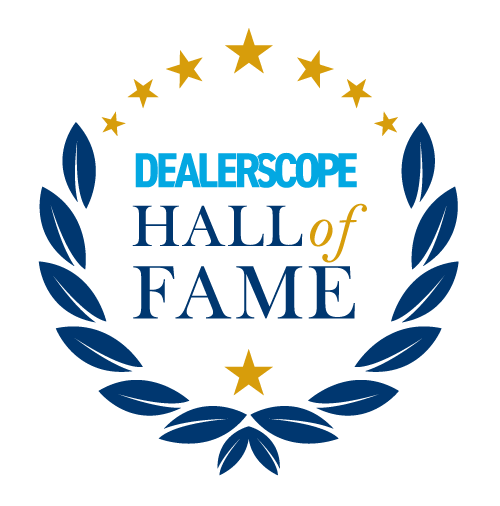


ATUL VIR
Founder and President
Equator Advanced Appliances
Atul Vir isn’t just an executive; he’s also a founder, inventor, and author. The CEO of Equator Advanced Appliances holds 18 different patents in appliance technology, and in addition to his success, he’s been widely cited as an expert and thought leader on business ethics.
It all began with his idea of selling all-in-one washer/dryers to the North American market. Though Equator started as an import/export company, it has now grown into a massive appliance firm that sells its products, in many categories, in Europe and Asia as well as in North America. The company has been mentioned more than 1,000 times in the media and has won such awards as Adex Platinum, Design Journal Best of Show, and CEDIA Expo Best of Show. Vir is the author of the 2019 book Underdog Thinking: A Bold Idea, a Business Adventure and 101 Lessons Learned Along the Way.
How did you get started in this business?
I was an immigrant to the U.S. and I was finding it difficult to get a job, so I decided to get into business myself. I started Equator as an import/export company and lived in Europe for some time. I was dabbling in various imports and exports, and about a year later, I discovered that there were no combination washer/dryers here in the U.S.
We were living in an apartment, and my wife was spending every Sunday doing the laundry, going to the coin-op machine, putting clothes in and coming back, then 45 minutes later transferring to the dryer and coming back, and then going back again to pick up the clothes. It seemed like a real chore.
I remembered we had used one of these in England when we were there, being an import/export company, I decided there’s something there. I went back to Europe and found a company from Italy at a trade show that would make it for us. And that started this long quest. I cashed out my credit cards to buy the first container, and brought it in, and started selling them one by one.
And you know, I just grew it from there, until the business really expanded and then that’s how, after a few years, I shut everything else down, and how Equator became an appliance company. I started Equator about 30 years ago, and about three years later it became a full-fledged appliance company, and that’s what we’ve been doing. And it’s expanded from there, from laundry into dishwashers and a whole bunch of other products.
Please share some milestones, and what makes you most proud about your career?
The first thing is, of course, as an immigrant, I had the opportunity to participate and see, firsthand, the American Dream, which basically is you can be anyone, and work hard, and you get an opportunity to succeed. So I was able to do that, I got the opportunity, and I also seized the opportunity, and many people gave me the opportunity as well. So, you go around, and you have a product to sell, and you present yourself and people have to trust you, and you have to build that trust until you reach a stage.
And I think the next point is that from just running an import/export company, I became a product developer and a designer, and I got deeper into appliances. I became an inventor, and now I have 18 patents in my name in laundry technology and other technology. And I developed these patents by learning about and understanding what customers wanted, rather than just saying this is what I want to produce, and telling customers this is what I produced and this is what you buy.
How would you describe your management style?
My management style is more of a flat style, in the way that every company has a pyramid and I’m the CEO and president and I’m at the top. But it’s an open-door policy, and anybody can come in and visit me, and say if they have a problem with their supervisor or manager.
Having said that, I do empower my managers to make day-to-day decisions. They can hire their people for their team, but they cannot fire; that’s where I draw the line. They can have a disagreement, but they cannot fire, because once an employee is there, even if they’re hired by somebody else, they then become a company asset. If they have a problem, even if it’s somebody six months on the job, then that’s six months the company has invested in them, and that’s when I step in and say no – unless it’s really something bad.
The other thing is, we reward innovation in our company, whether it’s process innovation or product innovation. I try to get everybody involved, whether it’s the accounting department or the customer service department. Because they’re all users of appliances, and they can suggest improvements, and they’re rewarded for that.


Which executives in the CE industry
do you admire most, and why?
I think the most influential person in our industry would be Steve Jobs. Even though you could say that I’m in the appliance industry, I think what he really taught us was to think, and how to think outside the box. And he was the most customer-centric person in trying to understand what customers thought, and trying to understand what customers would want, even before they would want it, or even know that it existed.
In our current day, it would be Elon Musk, who is, again, not directly in our industry, but he’s talking about artificial intelligence, and implanting chips in the brain, and I think we’re going in that direction. He’s showing us now, in our generation, how to do the same thing.
What’s the best business advice you ever received, and how did it help you?
The best advice I think I’ve received is, keep your eyes open, and your ears to the ground. And that was said in my previous job, before I started Equator, so it was 30 years ago and I was very young. I was working with a company in England, and the chairman of the company said that. And I didn’t understand it at that time, but now I see that’s key.
Every day, things are happening in your industry or your environment that affect us, and we are all living in this thing, and you’ve got to know what’s happening, or else you can miss something.
Whether you’re keeping an eye on your competitors, or the exchange rates, or the government, or the regulations, or what’s happening in China, you’ve just got to keep an eye out and look for things. And if you miss something, it’s a problem; you cannot allow that to happen.
Tell us a little bit about your personal
life past and present.
I grew up in India, I went to a military boarding school, my father was a Naval officer, and a war veteran, fought in the Korean War, in the British Navy – he was in the Indian Navy, part of the British Navy at the time; it was part of the Commonwealth forces. Because he was moving around, I was a Navy brat and was sent to boarding school, a military boarding school with long traditions. So I grew up with a lot of order and structure and things being organized, and I think I reflect that in the company that I run, that things should be very organized.
So, I did all my education in India. I did my Masters degree, and then I got a job opportunity in England, actually, with this company that was looking for someone with my experience. I had a Masters in business and [the equivalent of] a CPA degree. And so they had projects in Africa and other countries, and I was in the field in many different countries. And I worked for the company for seven or eight years.
And meanwhile, I met my wife; she’s from New York, and she worked in the World Trade Center. And so we dated, and then — she worked for the Attorney General’s office at the time, and worked on some big projects… so she moved to Africa, and then we got married, and we were there for a few years. Then the company had some financial trouble, and I decided to leave [when] my daughter was being born. [My wife] came here and got a job, and I decided to become an entrepreneur and started Equator, and that was in 1991.
I entered, and I couldn’t get a job. It was the middle of the [Gulf War] and there was a recession at the time as well. So when I came, it was a difficult time, and I needed to start something. So I started Equator, and just grew it from there. And we’ve grown now, we’re an international company, we have operations in Canada, and in India, and a few other countries.
What will be the future of our business,
and of retailing, in two years and five years?
On the product side, particularly the major appliances that we deal with, we’re seeing that more and more everything’s going to be connected with Wi-Fi. But I’m still concerned with machines being hacked, and so on, and people accessing information through your computers… we’re still a little bit concerned with those things in fully automated homes.
We have different kinds of customers. We make compact appliances that are mainly used by Millennials and seniors. And the seniors don’t want anything to do with this, they’re happy turning knobs and having straightforward functions. But it’s the [Millennials] that are demanding these kinds of features, and we’re trying to figure out which ones will be safe and so on.
Apart from that, we know that e-commerce is growing, and so we have to anticipate that people have less and less patience. They say if you have a product, it must work. You go online, and you pick a button, they expect it to be delivered next day, in good condition, and with no damage, and you open the box, you plug it in, nobody wants to read any owner’s manuals anymore. And you should know how to operate it.
So it is the responsibility of our side – the manufacturers – but how do we jump through these hoops? We’re a company that makes products, but how do we manage the logistics, and make sure products don’t get damaged, and improve the packing, and make them easier to carry? So we actually have changed the design – in the old days, we used to tell customers to read the manual. That doesn’t work anymore.
So we’ve redesigned our products on the assumption that nobody reads manuals. They [expect] to open it and plug and plug, which is quite difficult to do. I go back to Steve Jobs, and how he made an iPhone that has no owner’s manual to it, and it’s intuitive for what you have to do. So we have to think in those terms, in product design, and go through all those hoops to make a customer happy. Because if there’s any reason to return the product, they will do it.
–Stephen Silver








DANIEL LEE
Vice President & General Manager, Consumer NA
Harman International
Daniel Lee has worked at several major consumer tech companies, including Samsung, JBL, and LG, where he worked on launching the “Life’s Good” campaign. Now at Harman, Daniel Lee is best known for his important role in the launch of consumer brands and products, including Harman’s lifestyle audio brands, as well as his work in maintaining the growth trajectory of Harman’s current brands in challenging times. The consumer division of Harman, which was acquired by Samsung Electronics in 2017, has drawn acclaim of late for everything from the launch of a power accessories category to headphones endorsed by Dwayne “The Rock” Johnson and NBA Finals MVP Giannis Antetokounmpo.
What are you most proud of in your career?
The trust built over the years with dealers and partners has fortified my ability to understand the demands from all aspects of the business: retailers, partners, and consumers.
What’s the best business advice you ever received?
It is imperative to get the who, how, and what as precisely as possible to make the most groundbreaking impact.
Describe your management style.
Avoid the old way or the old-fashioned way. Embrace change and work with key stakeholders throughout your organization and with partners to establish trust and gain trust at all levels.
I enjoy making decisions based on data-driven analytics, and pride myself as a thought leader across all functions to nurture the development of the right culture within the organization, creating profitable opportunities for retail partners, and taking the necessary steps to always anticipate the customer value proposition.
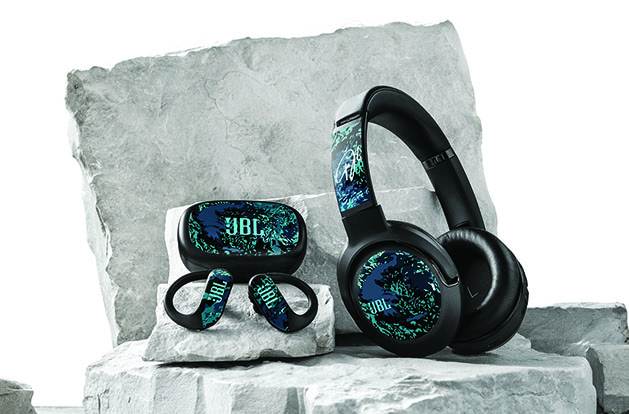

Which executives in the CE industry
do you admire most, and why?
I have been blessed to work with many impactful leaders throughout my career, but Dave Rogers, president of Harman Lifestyle, has had the most influence. His energy, humility, and compassion are characteristics that impact the entire organization and his intensity of being focused not on himself but on others are truly the keys to success.
Tell us a little bit about your personal life past and present.
I was born and raised in New Jersey and graduated from Cornell University’s Samuel Curtis Johnson Graduate School of Management
What will be the future of our business, and of retailing, in two years and in five years?
What I have learned over the last 20-plus months is to truly minimize distractions, focus on the main plan but have ready and in place a justified Option Two and Option Three. The CE industry has been quick to adapt and engage in varying consumer behaviors. Brands have positioned themselves to become even more relevant to each consumer demographic. During this generational shift, the consumer, in all segments, has become accustomed to eating, learning, and shopping differently. They have the upper hand in how, what, and when they want to purchase.
We are currently evolving into a new era of how we understand and interact with the consumer. Their pain points, their preferences, and how they consume the products we market will be elements necessary to build success for the next decade.
—Stephen Silver






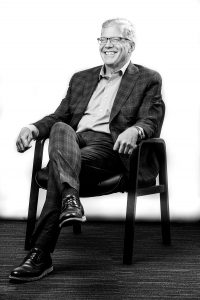

JOHN RIDDLE
President & CEO
Chairman of the Boar
Howard’s


Riddle’s keynote at LG’s InnoFest in 2017.
John Riddle grew up around appliances; his father ran a family appliance business in Central Pennsylvania that’s still in operation today. He has spent more than four decades in executive leadership positions in the appliance and CE industries, first at Maytag, where he spent 21 years as Vice President and General Manager of the Maytag Builder Solutions Group, adding $78 million in new suppliers in the process. Until his retirement in 2018, he spent seven years overseeing $4 billion of business as the Vice President of Home Appliances & Air Solutions at LG Electronics, which today is a household name in home appliances stateside as well as internationally. Riddle was so good at his job that he was lured out of retirement in 2019 to head up Southern California appliance retailer Howard’s, which has expanded into new locations over the past two years even as the pandemic persisted. In February 2021, Riddle also became Chairman of the Howard’s board.
Please share some highlights of your career, and what makes you most proud.
I believe every person has a different career path, that brings on different challenges, different victories and different milestones. I am a pent-up teacher, so anything I can be doing to teach is a victory for me.
I got into my first formal leadership position in 1991 at Maytag Corporation, managing a team in sales, customer channels, administration, service, inventory, and warehouses. In my first six months in the role, our team lost three of the top four largest customers.
From this setback, I learned about agility, about being entrepreneurial, about keeping your cool under fire and about building block by block. I had a young team, and they helped us craft a vision and strategy on how to rebuild the region in Pennsylvania, Maryland, Western and Upstate New York and West Virginia. I also learned early as a leader, that not everybody would “buy-in” to the vision or the heavy lifting to drive improvement. Some team members, a small minority, saw the “me” more than the “we.” That’s the obligation of the leader — to lead by example and lead for the good of the pack, versus the lone, sole, individual performers. Those metrics, by the way, exist on all teams. It’s the leader’s job to make the right calls on people.
I have never had an assignment in my career where I stayed in the same role for as long — seven years in this region. But, it allowed me to see the bottom to and see what’s needed to get to the top and pull away from competitors and succeed. In hindsight, I was really lucky to get this role early, experience failure, and have a great team that pulled through.


From left, John Taylor, current Chairman of AHAM, and Riddle, when he was appointed to the Board of Director’s of AHAM in 2016.
Describe your management style.
I believe my management style/mantra would be cheetah pace and openness to new ideas. Speed kills the competition. I truly believe you must be faster than your competitor.
Which executives in the CE industry
do you admire most, and why?
Mr. Kent Baker in the industry is the leader I admire most. He taught me at a very early age at Maytag to take responsibility for my decisions and be accountable for my objectives. You have to be mature as a leader, as a coach, as a parent, etc.
What’s the best business advice you ever received, and how did it help you?
After graduation from college, I decided to abandon a childhood dream I had of working in my family’s appliance and television business. On the day before I left my home in Pennsylvania to drive to Maytag’s headquarters in Newton, Iowa, my Dad asked to talk to me in the store. He said that he had one wish for me, which was not to be arrogant, not to act like God’s gift to the dealer from Maytag. :0) That advice paid dividends to me over my career, in a huge way. Companies with big brands often take an attitude of superiority to others, including customers. That is such a huge mistake.
Tell us a little bit about your personal life past and present: where did you grow up, etc.?
I grew up in Hanover, Pa. I enjoyed sports, played football and track in school. I am the youngest of seven children. I graduated from York College, a very old school that opened in downtown York in 1787. I have lived in Iowa twice, California four times, Denver, Washington, D.C., Pittsburgh, Atlanta, Austin, Augusta, Orlando, and Northern New Jersey. I worked in leadership roles for Maytag, Philips, Electrolux, Hisense, LG, and now Howard’s. I have two children, one in Georgia and one in Minneapolis, and my grandson in Minneapolis, too.
What will be the future of our business, and
of retailing, in two years and in five years?
I believe the future of our business in major appliances is doing a far better job serving the consumer. Consumers deserve a playground to try new technology and experiment with product before purchasing. The consumer deserves a simple, easy, and friction-free experience and delivery process. That is my mission in life right now at Howard’s. I could not be happier, being back at home, in the retail appliance business.








ROBERT ZOHN
Founder and President
Value Electronics
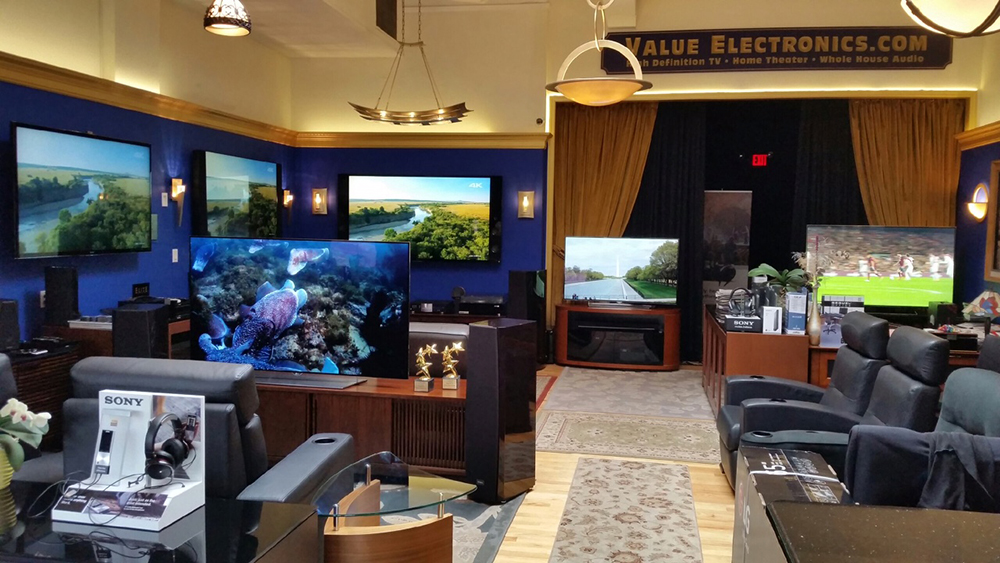

The Value Electronics showroom in Scarsdale, NY.
Robert Zohn knows his stuff. As a TV broadcast systems engineer from 1986 to 1998, he worked closely with the transition from analog TV to digital HDTV and ATSC 1.0. He is passionate about visual technology, which is why in November 1998 he founded Value Electronics in Scarsdale, N.Y. Besides evangelizing the best new TV and audio to consumers, Zohn created the annual TV Shootout event, which brings video, CE, and entertainment industry professionals together every year to help evaluate and pick the best TVs of the year. The event is popular not only in the industry, but also with videophiles and enthusiasts everywhere, and the result is that some of the features and innovations you find in TVs today are due to the findings generating at these events every year.
How did you get started in this business?
My lifetime passion and career has always been photography, cinema, audio, and TV broadcast systems design.
I was a TV broadcast systems engineer from 1986 to 1998, and I worked very closely with the transition from analog TV to digital HDTV, when ATSC 1.0 was created. I was so very impressed with the higher resolutions, the new color gamut rec.709, and, most importantly, the move to 8-bit signal, beautifully compressed into the 6 MHz broadcast channel bandwidth. This was also the birth of multi-channel surround sound over broadcast channels.
Being a lover of premium audio and video, I wanted to bring all of the values and highest level of state-of-the-art A/V performance to discerning consumers, so I decided to leave my successful A/V systems engineer career and open my own business with a retail showroom to demonstrate the latest premium A/V systems, integration, and custom installation. Hence, the start of Value Electronics in November 1998.
What are some milestones from your career, and what makes you most proud?
We’ve always been on the cutting edge of A/V technology advancements and bringing world-class A/V entertainment systems to consumers. One of my most rewarding accomplishments is getting calls and emails from clients telling us how much their families are enjoying the systems we designed and installed in their homes.
I enjoy educating the public on how to get the best performance from their A/V systems. To help support my goals of getting more families interested in the advantages of the latest high-performance A/V equipment, I write technical white papers. I’m also a frequent public presenter at CES, CEDIA, CE Week, IBC, and other trade and consumer events. I’m also active on several A/V user forums and many live podcasts on my favorite YouTube A/V channels.
One of my favorite accomplishments is the creation of our annual TV Shootout Evaluation event. We just completed our 18th annual TV Shootout. I created the event to determine who makes the best TV in each model year by accurately comparing and evaluating all of the image performance attributes. We rate each attribute for every TV on an easy-to-read matrix chart so that consumers can select the best TV for their use, room conditions, and budget.
One big additional benefit that naturally came from our annual TV Shootout is that all of the TV manufacturers watch and follow the event. Many chief engineers also attend the event in person to learn how they compete and compare with the other brands. This has led to many enhancements and fixes for issues we found and disclosed at the TV Shootouts.
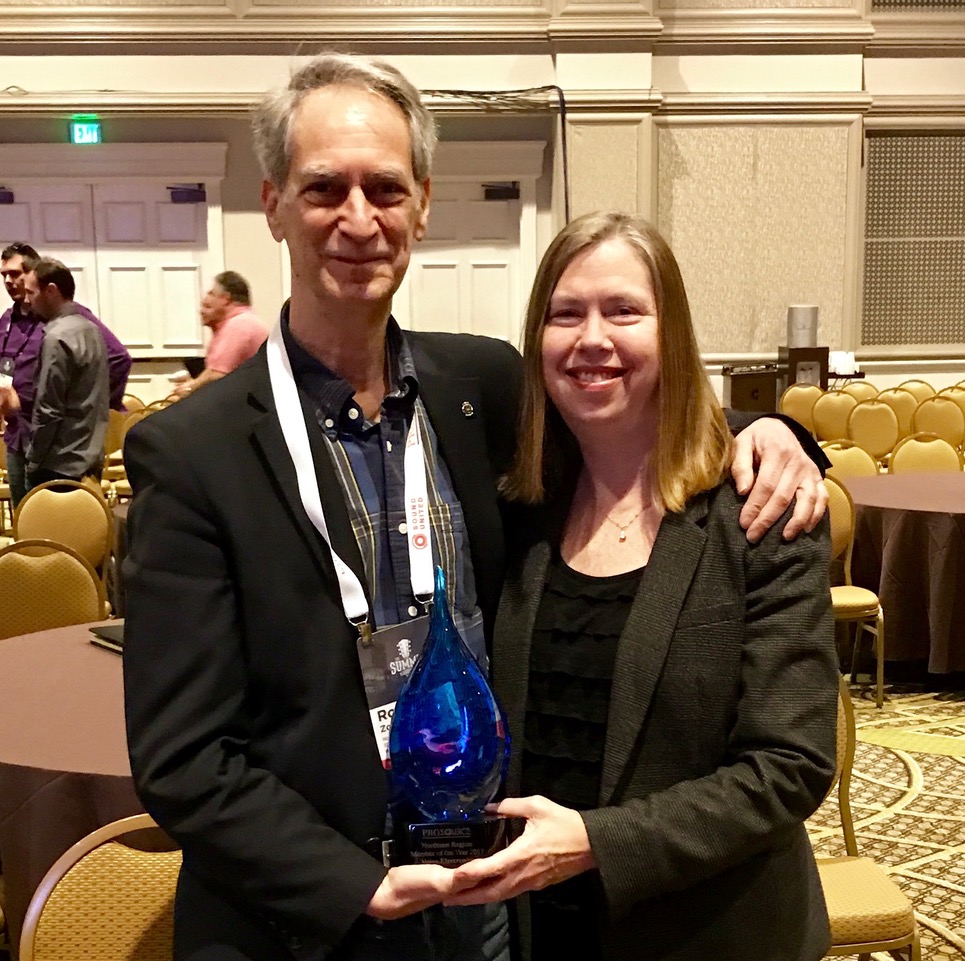

Zohn after winning “Dealer of the Year” in 2017.
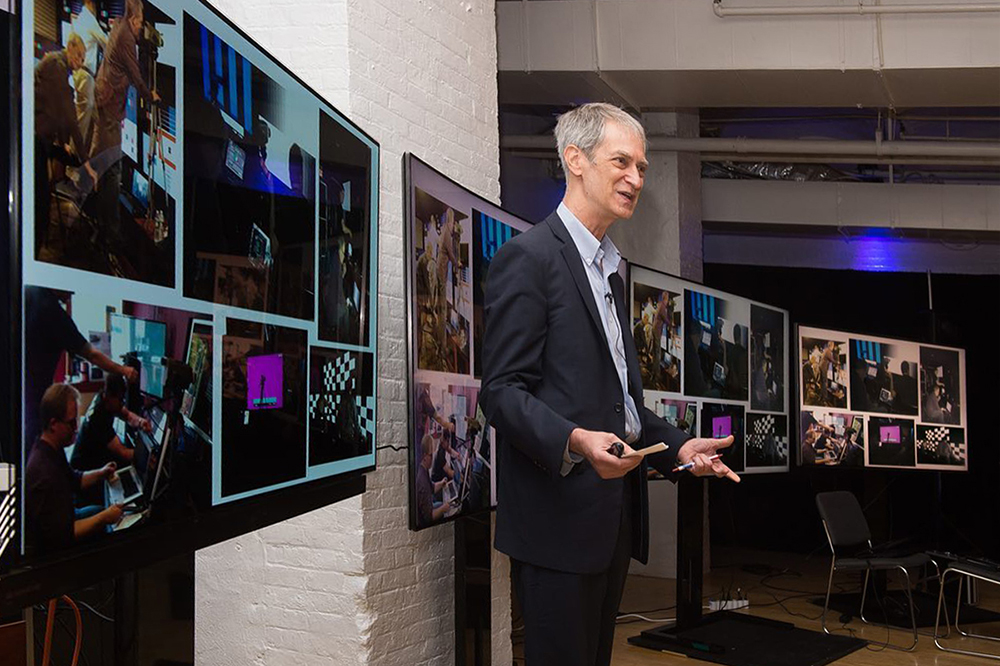

Zohn presenting at the 2019 TV Shootout.
Describe your management style.
I have a soft and very friendly management style, and we show our appreciation when an employee goes beyond the normal expected work. We enjoy a positive relationship with our staff and subcontractors.
Which executives in the CE industry
do you admire most, and why?
I have always been influenced by exceptionally talented, brilliant people who also have positive and friendly personalities. From childhood, I’ve been very fortunate to know a lot of positive and very successful people with whom I have enjoyed a close relationship.
In the CE Industry, my collaboration with Joel Silver of the Imaging Science Foundation has inspired me and helped support our annual TV Shootout evaluation event.
I hold my friendship with Dr. Larry Weber and Bill Schindler, who are the creators of the plasma TV, very dearly. They have also helped support our annual TV Shootout event.
What’s the best business advice you ever received, and how did it help you?
Be focused and dedicated in everything you do, and work hard to achieve the best possible results. Another very important business lesson is to always provide the best in customer service and support.
We built our company on these principles to be one of the top independent A/V retailers, and our growth is at a strong and steady pace.
Tell us a little bit about your personal life
past and present.
I was born and raised in Bayside, Queens, N.Y. I was lucky to have lots of very great friends, [gone to] excellent public schools, and [have] loving and supportive parents. I have three siblings — my younger sister, who very sadly died at 48 years old, and two older brothers, who are doing fine and have also been a positive influence in my life. Photography and cinematography were hobbies of mine at an early age, and that is what led to an interest in this field.
Currently, I live in Westchester County with my wife, Wendy, who is my business partner. We have three kids, a son-in-law, and a daughter-in-law.
What will be the future of the consumer technology business, and of retailing, in two years and in
five years?
The technology advancement in premium audio and video has expanded exponentially since digital TV was launched in 1998. This year’s TVs represent the biggest technology advancements we’ve seen in many years. Some examples are in the larger screen sizes; today we have consumer TVs up to 100 inches and we also have OLED emissive display TVs up to 83 inches, and some with specially designed heat sync.
Even more significant are the enhancements in video processing in this year’s TVs. One great example is Sony’s new XR Cognitive Intelligent processor. It means that Sony’s Bravia XR TVs this year have greatly improved in areas such as upconversion scaling of low-resolution content (cable), motion resolution from all content sources, contrast control throughout the entire dynamic tonal range, color accuracy, color saturation, and color volume. These TVs have leapfrogged like a bullfrog on steroids.
It’s difficult to imagine what further advancements will come in the TV and projector categories, as we have reached a level of excellent in performance that is very close to the human visual system’s ability, but we will continue to see improvements in contrast ratio performance, and the trend of larger screen sizes will become even more popular with new larger screen sizes.
We’ll also see advancements in the next generation of emissive display technology such as MicroLED, the return of convenience features like PIP [picture in picture] coming back to TVs, and advancements in 8K with new MiniLED TV models and better scaling to upgrade the incoming signal to the TV’s native 8K resolution.
For audio, we’ll see several new immersive Dolby Atmos, DTS:X, and Auro 3D soundbar audio systems.








ZACH ELKIN
President
Beko Home Appliances USA
Zach Elkin has been working in the appliance business for more than 25 years, and he is particularly known for revitalizations of existing brands in North America and beyond. He helped build up the luxury positioning of both BSH’s Thermador and Gaggenau brands in the U.S. and later, LG’s Signature Kitchen Suite, before taking charge of Turkish appliance maker Beko’s expansion in North America, in 2020. Thanks to its cleverly designed and eco-friendly appliances, Beko recently won a Best Affordable Dishwasher award from Reviewed.com, while also earning an Energy Star Sustained Excellence Award for innovative features such as EverFresh+ refrigerator technology for the third straight year in a row.
For his decades of work as an innovative mind in the branding and marketing of appliances, Elkin is a 2022 inductee in the Dealerscope Hall of Fame.
How did you get started in this business?
I’ve been an appliance guy since my first day on the job! Upon graduation from the University of Kentucky, I was recruited to join Sears as an outside builder salesperson for a new division, Sears Contract Sales in central Kentucky. After 2 1/2 years in sales, they persuaded – some would say tricked – me into accepting a promotion and relocating to St. Louis to open and lead a new regional builder organization for the Midwest. After establishing the Midwest office, I was given a similar assignment in Florida, followed by a series of leadership positions in the field and at Sears corporate – which eventually resulted in me being asked to lead all sales and marketing for the division.
I say “tricked” because while at the time I couldn’t imagine moving from my beloved Kentucky to St. Louis to assume a newly created regional position, that challenge from Sears was one of the best things that ever happened to me, and set me up for much of the success that followed. I am grateful for my early days at Sears and the faith they had in a young kid from Kentucky.
Please share some career highlights
and milestones.
The highlight of my career has to be the people that I’ve had the opportunity to work with and the team we’ve built – not just at Beko but throughout my journey at the biggest brands in this business!
The major milestones would be leading Contract Sales for Sears, the startup of the builder division at BSH, the revitalization of the Thermador brand for BSH, the vision and launch of Bosch Benchmark for BSH, the establishment of the Signature Kitchen Suite for LG and, of course, the great privilege of leading the team at Beko, which has become the fastest-growing and most sustainable home appliance brand in the U.S.
What makes you most proud about your career?
It would clearly be the people that I have worked with and teams we have built. I have been blessed to partner with some of the best and smartest people in the industry – including the team at Dealerscope.
What has been especially rewarding is the fact that many of these relationships have lasted through many years and many brands – which gives me the unique opportunity to build a best-in-class team of product and brand experts and dealers, designers, builders, and other influencers at Beko.
Describe your management style.
My colleagues describe me as focused on the larger outcome for the brand – and on setting goals for the team and helping them to reach these goals rather than dwelling on the specifics.
I’m a big believer in open, honest communication and setting clear expectations for the team as a way to achieve cohesion and establish and maintain strong morale. I know people respond when you invite them to participate in a larger mission that intersects with their values – much like how my team at Beko U.S. is personally connected to Beko’s brand mantra of health, wellness, and sustainability.
People also tell me that I’m comfortable delegating authority, eager to discuss ideas with others to form a consensus, and amenable to changing my mind – and the plan – if it contributes to the larger goal. It’s also flattering when my colleagues credit me with a quick, friendly and approachable management style and ability to partner and lead many different employees and personalities at all levels.


Which executives in the CE industry
do you admire most, and why?
Bill Maines from GEA/Sears and Michael Traub of BSH. I had the privilege to work directly for both of these leaders. Both of them possess great interpersonal skills and are great listeners and terrific collaborators to get the best results from their team.
But as two of the best strategists I know, they are also analytical in their approaches and quick to embrace change and the challenge of building a best-in-class team and culture.
What’s the best business advice you ever received, and how did it help you?
“In God we trust; everyone else bring data,” was one of my mentor’s favorite comments about making changes to a business plan. An example would be the Sears market research we did on homebuilder appliance preferences to launch Sears Appliance Select, an in-store highly profitable Home Buyer Selection Center for appliances.
“Fail Fast” is another go-to. This principle supports “out-of-the-box” thinking, free experimenting, and learning while trying to reach the desired result. Our “One, Two, Free” promotional program for Thermador is a great illustration of this; what started as a six-month experiment many, many years ago is still going strong today.
Tell us a little bit about your personal life
past and present.
I was born, raised, and educated in Lexington, Ky. I married my high school sweetheart and have two adult sons, a wonderful daughter-in-law, along with a grandson and new granddaughter. For relaxation, I spend time on Tellico Lake in Tennessee, and I’m an active member of the BBN (Big Blue Nation) –
so I try not to miss a Wildcat football or
basketball game!
What will be the future of our business, and of retailing, in two years and in five?
I’m a big believer that all of us can have an impact on inventing – or reinventing – our future. My recommendation for the independent and specialty appliance retailer is don’t try to be everything to everybody. Instead, be authentic, and stay true to your unique business capabilities and brand DNA. Focus on what you do best, such as delivering the best, hands-on in-store experience supported by true sales professionals. Leverage your relationships and trusted brand partnerships to be the go-to appliance dealer in your market for professional delivery, installation and no-hassle, after-sales service.
The future of the appliance industry will be centered around sustainability – with more than 72,000 home appliances failing daily, we have the opportunity to work together to rethink recycling as part of our industry’s larger earth-friendly legacy.
Because, as we say at Beko, healthy living is only truly possible on a healthy planet.


SPECIAL ADVERTISING FEATURE
Nationwide Marketing Group
Member-Focused and Performance-Driven
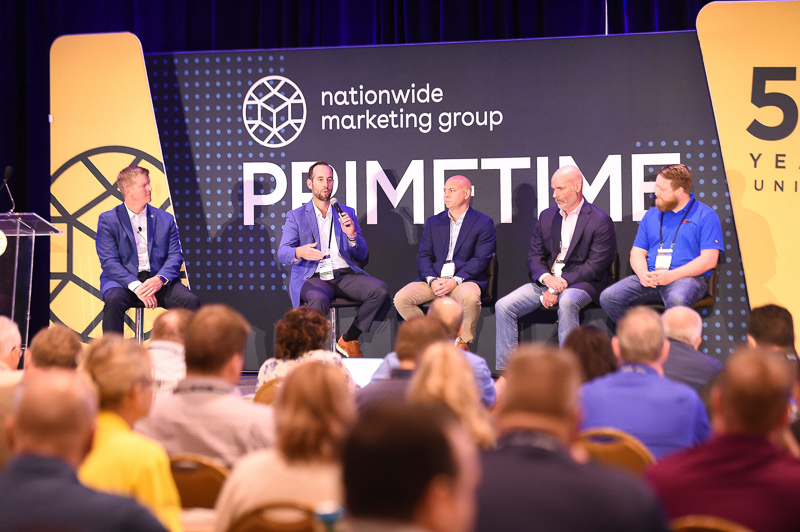

In today’s unsettled and unpredictable marketplace, Members of Nationwide Marketing Group are thriving. They’re taking market share, expanding their operations, and outpacing the industry, even in the face of the immense challenges the industry faced over the past year. And they’re attracting shoppers with the most advanced digital marketing platform in the Independent channel, converting them into customers both in store and online with the best-educated teams in the business, and reducing costs with unmatched buying power and comprehensive financial services.
With more than 5,000 Members who operate some 14,000 storefronts, Nationwide’s retailers represent the most influential voices in the Independent appliance, electronics, furniture, bedding, outdoor entertainment and connected services industries. The group’s semi-annual PrimeTime events deliver the largest gathering of Independent dealers in the channel’s history – even when those gatherings have to happen in a virtual setting. Part product exhibition and buying show with some of the deepest deals of the year, and part educational conferences with a curriculum of hundreds of sessions, PrimeTime is attended by thousands of Members and Vendor Partners. It also provides Member-to-Member networking, access to key decision-makers and industry authorities, plus updates on the latest trends and issues affecting Members’ businesses.
Now is a great time for Independents and an even better time for Members of Nationwide Marketing Group.
Nationwide Member Benefits Include:
- Unmatched scale for the largest aggregate purchasing opportunities in the channel.
- PrimeTime, the industry’s largest Independent buying show and Member conference.
- Group-exclusive sheltered products and private labels available in every major category.
- Industry-leading and group-supported digital marketing programs and website design services, which are constantly updated based on results from the channel’s largest reservoir of competitive data.
- Free access to powerful data-driven tools through the PriMetrix suite of programs, including personalized market- share analysis, the Assortment Rationalization Tool (ART) and the Retail Sales Analytics (RSA) platform, which are unavailable anywhere else in the industry.
- An exclusive partnership with AT&T that lets Members sell cell phones, cellular service, home internet and DIRECTV.
- Both group-provided and group-supported digital and traditional advertising assets and programs, from web video and TV commercials to in-store video, print materials and more.
- Group-negotiated inventory finance and retail finance programs, plus low credit card processing and business insurance programs.
- Nationwide Learning Academy live sessions and workshops held regionally and during both in-person and Virtual PrimeTime.
- The Nationwide Learning Academy online, a mobile-optimized video learning platform with hundreds
of new learning modules developed each year and hundreds of thousands of Member certifications annually. - Nationwide’s eXchange CE purchasing portal, featuring pricing comparisons and product information from the industry’s leading CE distributors.
- Access to affordable insurance coverage from Lockton Affinity, with the channel’s first and only health insurance program exclusively for Independent retailers and their employees.
- A dedicated dealer-driven servicer peer group designed to focus on best practices and addressing issues that servicers face.


Nationwide Marketing Group
Tom Hickman,
President and Chief
Member Advocate
609 N. Liberty St.
Winston-Salem, NC 27101
NationwideGroup.org
336.722.4681


SPECIAL ADVERTISING FEATURE
The PowerHouse Alliance


The Ui Supplies Ramsey, NJ location
The PowerHouse Alliance is a distributor group serving dealers and integrators across the United States with 55+ locations and over 850,000 square feet of warehouse space. PowerHouse Alliance members have continued to expanded and open new locations to keep up with dealer demand. In 2021 alone, PowerHouse members KOA, ECD, Pioneer Music, Mountain West, Sierra Select, 21st Century Distributing, and Alarmax have all either opened brand-new additional locations or moved into larger locations to be able to accommodate the needs of their dealers.
Collectively, the PowerHouse Alliance stocks over 250 brands spanning residential and light commercial categories, including home theatre and control, AV, security, networking, consumer electronics, lighting, shades, accessories, and more, with convenient will call locations nationwide. Dealers can also take advantage of convenient 24-hour will-call hours and online ordering of the top brands that PowerHouse Alliance members stock, also available for same-day or next-day delivery anywhere in the U.S.
The group continuously looks for new and innovative lines to add/complement, and also sells its own exclusive house brand, A2V. The A2V brand was created to bring dealers high-quality products backed by long-term warranty, complemented by excellent dealer margins and an industry-leading rebate program. Currently A2V includes subwoofers, in-wall, in-ceiling and outdoor speakers, HDMI cables, racks, mounts, and fiber, available at all PowerHouse Alliance member locations.
In addition to product support through top brands and the A2V line, the PowerHouse Alliance members support their dealers with a year-round, no-charge, in-depth monthly training schedule across the country so they can learn about the newest products, technologies, installation methods and best practices available. Adding to the already extensive training schedule, in 2022, the PowerHouse Alliance will begin offering new in-person training as part of CEDIA’s preferred education partner program. Each PowerHouse Alliance location will have a CEDIA-certified instructor on location, offering peace of mind to dealers to ensure that their new hires are learning the correct protocols and standards to succeed on the job and in the industry. PowerHouse will be looking to host at least one accredited training per PowerHouse location each quarter.
“The PowerHouse Alliance is a one-stop shop that spans the country with over 55 convenient locations for dealers. Whether they’re looking for audio, displays, networking, security, smart home, lighting, shades, commercial, etc., we have thousands of products to meet their needs,” comments PowerHouse Alliance Executive Director Dennis Holzer. “Our team is well-versed in product and installation knowledge to help dealers choose product, detail jobs, and offer great deals for them to take advantage of, either by stopping by the member’s location for same-day stock, or ordering product online in advance.”
PowerHouse Alliance members include: 21st Century (Raleigh, NC; Charlotte, NC; Atlanta, GA; Orlando, FL; Nashville, TN), AlarMax (Pittsburgh, PA), Next Level (Jupiter, FL; Marietta, GA), Next Level Midwest (Northbrook, IL; Elk Grove Village, IL; New Berlin, WI; Bloomington, MN), Davis Distribution (Newell, WV; Indianapolis, IN), ECD (Houston, TX; Carrollton, TX; Austin, TX; San Antonio, TX), KOA CCTV (North Hollywood, CA; Glendale, CA; Anaheim, CA; Los Angeles, CA; Canoga Park, CA; Sylmar, CA; San Diego, CA; Las Vegas, NV), Mountain West (Salt Lake City, UT; Denver, CO; Scottsdale, AZ; Seattle, WA), Pioneer Music Company (Chanute, KS; Lenexa, KS; Omaha, NE; Chesterfield, MO), Pro Audio Associates (Woburn, MA; Canton, MA), Sierra Select (North Highlands, CA), and Ui Supplies (Ramsey, NJ; Plainview, NY).
The PowerHouse Alliance distributes over 250 brands including: A2V, Samsung, Apple, Yamaha, MSE Audio, Hikvision, KEF, eero, VIZIO, JVC, Ubiquiti, Universal Remote Control, Séura, Luxul, Panamax, SunFire, Sanus / Chief, Peerless AV, Legrand, Neptune, Platinum Tools, DaLite, 2GIG, Nest, Wyrestorm, Hikvision, Digital Watchdog, Vanco, Middle Atlantic, Zigen, Yale, Kwikset, Just Add Power, Wilson, Powershades, MantelMount, Techlogix, and more.


PowerHouse Alliance
Dennis Holzer,
Executive Director
412-531-2068
2022 CE PREVIEW
New Year, New Trends
What to expect from consumer electronics in 2022.
By STEPHEN SILVER
It’s a new year, one very much plagued with uncertainty, from the status of the pandemic to component shortages to questions about inflation. Beyond that, the year will provide a picture of what a post-pandemic industry will look like.
NPD Group, in a forecast issued in August, predicted a seven percent increase in industry revenue in 2021, despite a one percent decline in unitsales. However, the research firm predicted a sevenpercent decline in revenue in 2022, with unit salesdropping six percent.
“Following the historically high sales in 2020 and 2021, we are anticipating near-term declines with a slow climb back to normalcy by the end of 2023,” NPD’s vice president and industry advisor, Stephen Baker, said in the August forecast.
In an interview with Dealerscope in early December, Baker laid out some expected trends in 2022.
“The first half of the year will be very difficult,” Baker said. “The comparisons to 2021 are extraordinarily challenging. In fact, Q1 2021, in terms of growth, was the highest growth number of all the pandemic quarters to date, so we have very difficult comparisons in Q1.
“You put that on top of the fact that we’ve had pretty close to two years now of an elevated sales environment, and at some point, the market is going to take a little more of a pause than it has, to absorb the new products.”
He added that, with hardware, install bases have gotten younger, leading to less replacement. In addition, he said, the “elevated cost environment” will continue to have an effect, with prices going up and demand going down.
The new year will kick off with CES in early January, but in the meantime, here are some looks at what to expect from the consumer tech world in 2022:


TVs
The Consumer Technology Association (CTA), in its forecast for the 2021 holidays, listed TVs as among the top wish-list items for consumers. And CES in 2022, like every other year, is going to feature TVs as among the most prominent products. Samsung is believed to finally be taking the wraps off its “QD-OLED” technology, which is said to combine all the best aspects of OLED and QLED TVs.
“The total TV market will be challenging, certainly, from a unit perspective,” Baker said. “But if you break it down, we see the premium markets and the larger screens far outperforming the overall environment for televisions.”
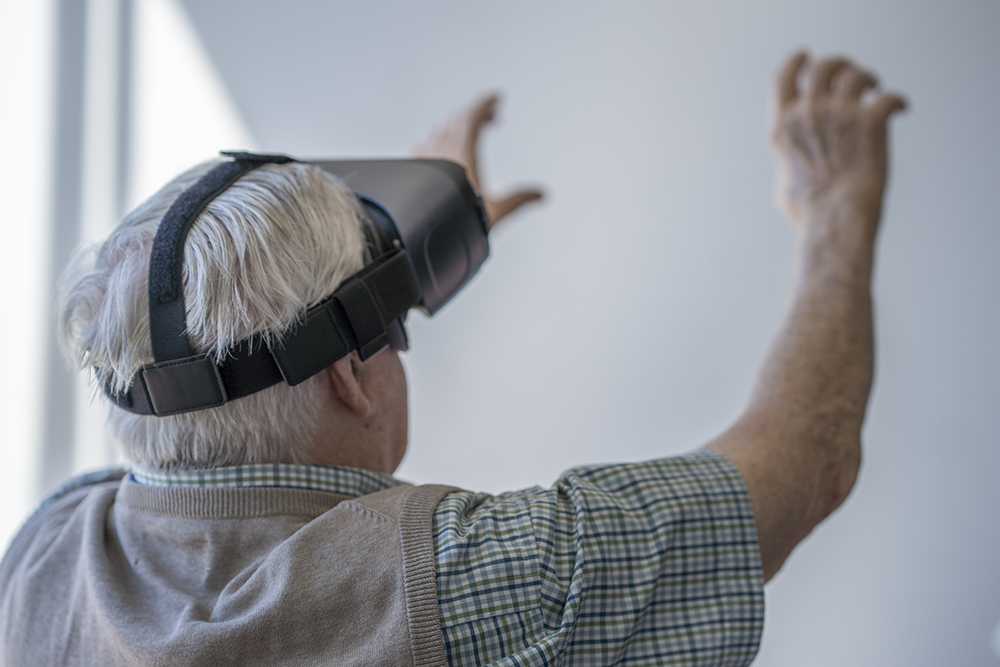

Digital health and safety tech
The pandemic has brought health into focus as never before, and in that holiday forecast, the CTA found that nearly a third of those surveyed were “interested in smart or connected health monitoring devices.”
Another category along those lines is digital therapeutics, sometimes called DTx, which includes everything from digital exercise programs to “virtual reality-based mental health apps,” CTA said in October. CTA recently convened the first accredited standards for digital therapeutics.


Smart homes
The smart home is going to be “one of the best-growth categories in 2022,” Baker predicted. He added that with the pandemic receding, consumers are likely to be looking more at security solutions, especially as the smart home “has become more ubiquitous.”


Cybersecurity
After a long series of security breaches and hacks in 2021, 2022 is shaping up as “The year of cybersecurity,” according to Security Magazine. The magazine predicted that in the new year, government regulations are expected to arrive dealing with how companies should handle cybersecurity concerns.
“Yes, it represents added pressure and cost, but most changes should already be practiced by most organizations, and they do indeed elevate the security posture,” the magazine said.


Drones
Drones have been a rising product for the better part of a decade. Analytics Insight recently listed some of the latest trends for drones, including in agriculture, construction and mining, and law enforcement, while the products continue to be used for recreational purposes.
And while the plans by Amazon and other companies to use drones for delivery have gotten a great deal of media attention, they’re still not ready for prime time.
“It’ll be a niche, as it is now,” Baker said. “There are a lot of challenges around that mode of transportation [and] we’re very much now in the testing phase.” He added that the business applications are where the potential is for drones, and “it will never be a significant consumer market.”


Food tech
The “food tech” category comprises everything from innovation in shipping and packaging, to the making of food itself.
In 2019, the Impossible Burger 2.0 was the surprise winner of Digital Trends’ Top Tech of CES Award, even though it’s hard to see it as tech in the traditional consumer electronics sense. And yet, the company, along with other next-gen, plant-based foods, are now staples of CES. More of the same is expected at CES 2022 and beyond, with David Bchiri, president of U.S. consulting firm Fabernovel, telling the International Business Times in November that 2022 will mark “the crowning year of food made from plant-based proteins.”
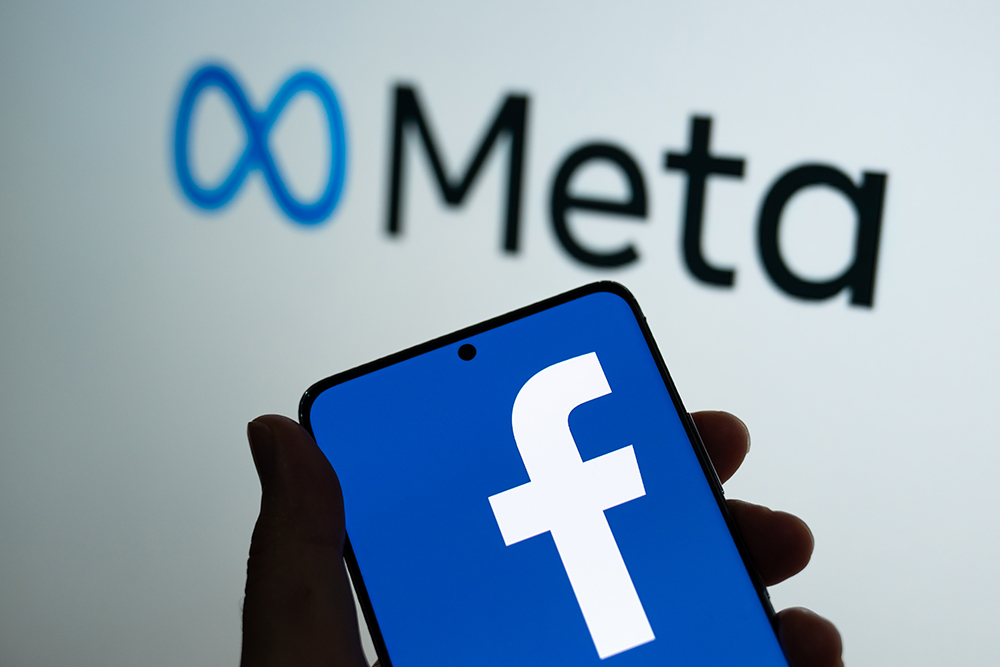

AR, VR, and the metaverse
Some sectors of the tech industry have gone all-in on the “metaverse,” most notably Facebook, which changed its name to “Meta” in the fall of 2021. And while most agree that full implementation of the metaverse remains a ways off, some of the products that will tie in with it are already available and thriving.
“Virtual-reality hardware, like the Oculus, has been one of the big winners this holiday,” Baker said. “And we would expect those kinds of products to do very well in 2022 as well.”
Back-from-the-dead product categories
There were some product categories, most notably webcams, that were thought to be relics of the distant past, until the pandemic made them suddenly valuable, and even occasioned shortages for a time. With the pandemic receding, what’s the future of the categories that got a new lease on life in the pandemic?
“They’re not gonna sell the kind of numbers they did in 2020, but a lot of those kinds of categories have found new life, both for communication, [and] for creator environments.” Baker added that microphones and digital picture frames have remained successful even after the lockdowns in 2020.


HEALTH & WELLNESS
Are These the Smartest Dumbbells in the Exercise Room?
We put the BowFlex SelectTech 552 hand weights
through their paces.
By JOHN R. QUAIN
Whether it’s due to a genuine fitness craze or primarily a gym-avoidance craze, sales of home fitness products continue their upward trend. And carried along with that trend are intelligent apps and gear aimed at the home gym. Even dumbbells are getting smarter.
Bowflex’s established SelectTech system is emblematic of the trend. Improved health notwithstanding, the company’s SelectTech 552 Dumbbells, for example, offer several benefits over traditional free weights.
A pair of the Bowflex SelectTech 552 hand weights costs $399 and can be adjusted from just five pounds each to 52.5 pounds each. That’s plenty of range for most of us. The lower weights are ideal for repairing a muscle tear or doing some rotator cuff strengthening, while the higher weights can be used by more experienced lifters to do bench presses and preacher curls.
To select different weights, each dumbbell has a dial on each end. This, in turn, determines how many discs get locked onto the hand weight. And with all the selections, it’s the equivalent of getting a set of 30 individual free weights in just two dumbbells. In testing, we found them also safer to use. A home vertical rack of traditional dumbbells can be awkward to manage, and it’s easy to drop or misalign a heavy weight in the rack (watch your fingers!). The Bowflex weights, by comparison, are simple and easy to store without needing a rack or cramped positioning.
Most of our shoulder and arm strength routines were easily accommodated by the SelectTech weights. It takes just a second or two to spin dials and change the weights for rapid supersets, for example. And you can’t mismatch or dangerously imbalance them by, say, selecting 25 pounds on one end and 40 pounds on the other end of a hand weight; they won’t let you lift them out of the stands if you do that. Nice safety feature.
However, some people may find the size of the weights a little tricky to manage. The SelectTech 552 Dumbbells are about 7.5 inches in diameter and 17 inches wide, side to side. Compare that to our old-fashioned fixed 40-pound dumbbell at home, which is 6 inches in diameter and about 12.5 inches wide.
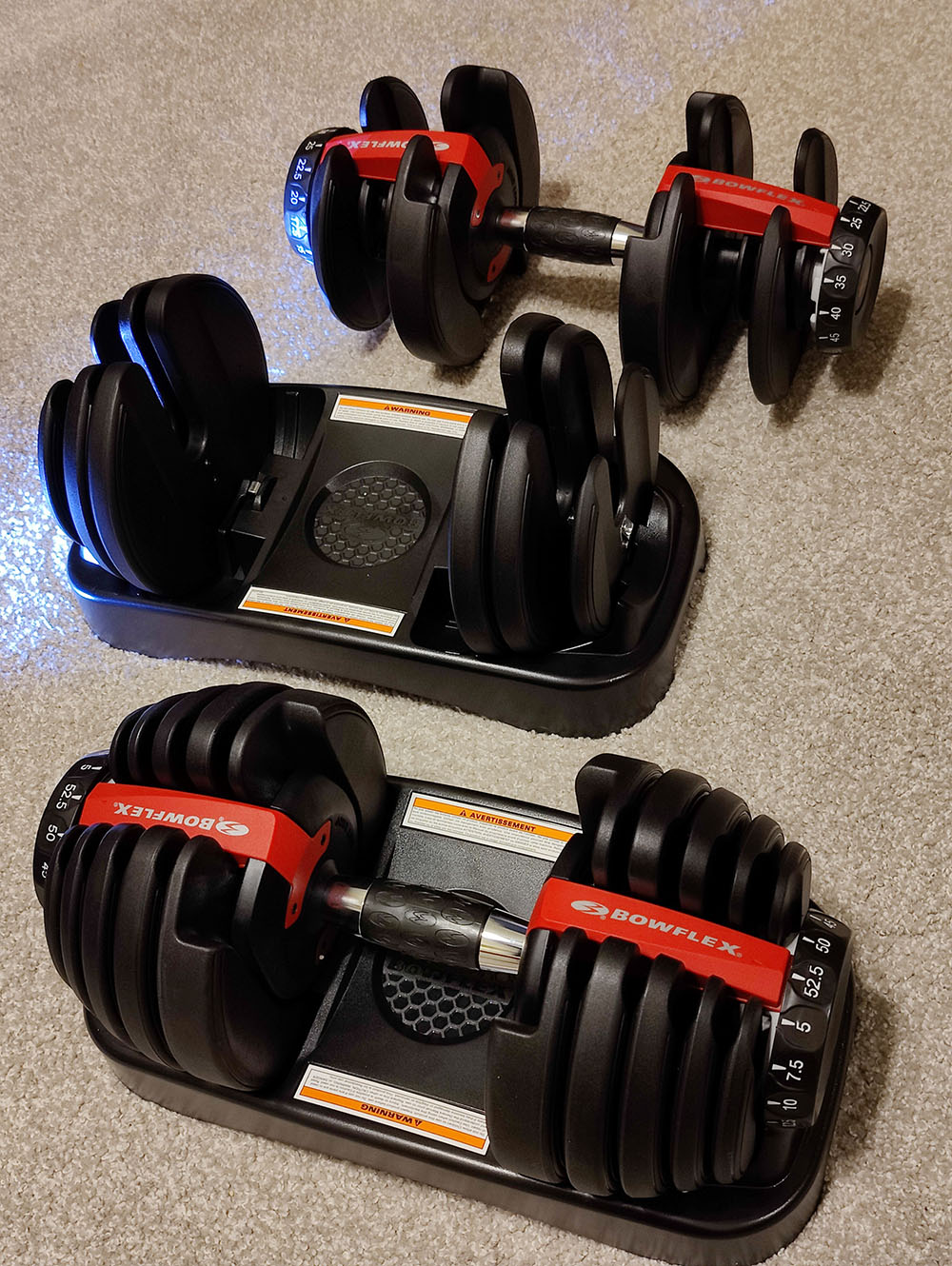



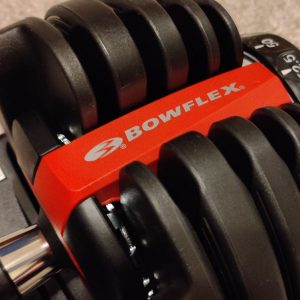

But the real smarts of the SelectTech system — like so many other fitness devices today — are really in its supporting custom apps. Designed to be used in conjunction with its weights, stationary bikes, and treadmills, Bowflex’s JRNY app for phones and tablets is $19.99 a month or $149 for the year for the software with video training sessions. Each is geared toward your level of fitness and particular goals (weight loss, improved strength, etc.) with tailored workouts to help keep you motivated and progressing. The video includes weight training sessions, as well as cardio classes for those with the very popular Bowflex C6 Bike ($999) or Bowflex Treadmill 10 ($1,999). And if you get bored with trim trainers urging you on, you can switch to streaming Netflix, Hulu, or Amazon Prime Video while your individualized progress data continues along the bottom of the screen.
Nonetheless, we still found the best feature of the Bowflex SelectTech 552 was the overall compactness of the free weight set compared to a large rack of traditional weights. It makes the SelectTech 552 perfect for cliff-dwellers, or those in smaller homes who don’t have the space for a dedicated workout room. If you do have a bit of extra space, there’s also a $179 SelectTech Dumbbell Stand with Media Rack, where you can also set a tablet for some of those streaming training sessions. All in all, for the equivalent of a few months’ gym membership, it’s a permanent solution on how to avoid going to the gym.
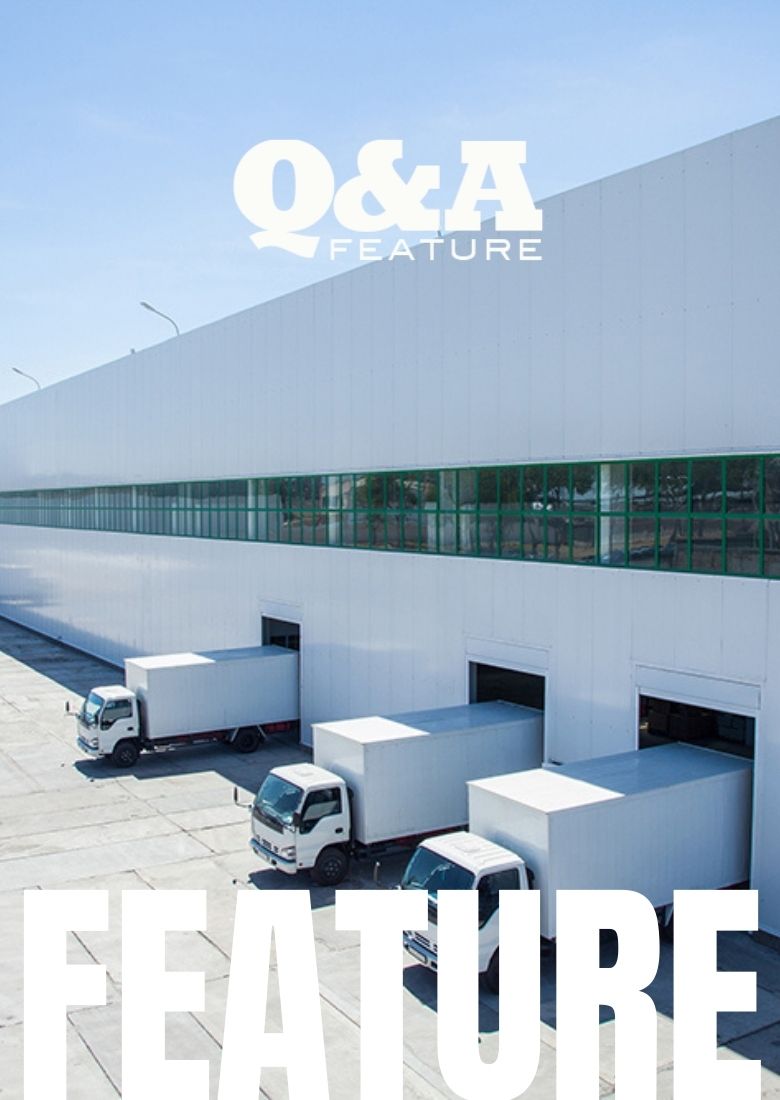

DISTRIBUTOR/BUYING GROUP
Bridging the COVID
Supply-Chain Gap
Dealers and integrators tell how buying groups and
distributors are digging deep into their wells of ingenuity to solve relentless pandemic-generated challenges.
COMPILED BY NANCY KLOSEK





How have the various business influences that have arisen lately – such as supply-chain disruptions, inflation, etc. – affected or shaped dealers’ and integrators’ relationships with distributors? How have they affected or shaped dealers’ and integrators’ relationships with buying groups?





Franklin Karp,
CMO, Audio Video Systems, Plainview, N.Y.:
[Regarding distributors and supply chain,] the well-financed ones are in better shape regarding product availability and getting allocation from their suppliers, but overall, it’s always a crapshoot. I needed a TV for myself in the bedroom and called my next-door distributor to ask what have you got in stock. And that was how I made my decision about what to buy. It may or may not have been what I’d have taken in a perfect situation, but it was something that I was OK with anyway. He had three and put one aside for me. Last year, they were dying to get rid of inventory; now they can’t get enough of it. Big change.
[Regarding buying groups], they have done a good job, without naming a specific one, of keeping members informed. Let’s face it – other than manufacturers’ email blasts that give updates, they’ve done a good job. Some do Saturday-morning updates and some do regulars updates when they get information. But it’s easier for a manufacturer to give good, solid information to one source and have that source distribute it. Also, at the same time, the buying groups are giving input in forecasting out based on what they’re told will and won’t be available. They’ve also done a good job taking advantage of this time to reacquaint the staffs of their membership with how to sell, 1-2-3. What’s happened over the years is people have forgotten some of the basic skills, and giving refreshers and “post-doctoral” training on Salesmanship and Business Management 101 – managing inventory and client expectations — is helpful. They’re doing constant reminders about keeping focused and keeping the ball bouncing. That’s important, because it’s human nature for people to get lazy, especially when business is really flowing in and you can’t possibly handle it. Taking on too much doesn’t make sense. You have to keep things in perspective.
We’re all in the same boat, and I don’t have better access than anyone else to equipment. Some manufacturers are being very straight, and [it works best] if you manage your business and project out realistically and are not putting phantom purchase orders in, so that when it comes time to ship, you don’t need to cancel the order because you ordered 10 and only really needed two, but thought it would put you higher on the manufacturer allocation list. If you need, say, three processors, you will get timely information from good manufacturers, those who are really managing their processes, as to when those goods are going to ship. You can’t control acts of nature, or the ships at the port, but smart manufacturers know within a reasonable amount of time when they’ll get goods.
Transparency during these times has become paramount. Working partnerships between the vendor, the dealer and the buying group in between has become more important than ever.





David Pidgeon,
CEO, Starpower, Dallas, Texas:
These influences bring you closer with the distributors. Now, they have become even more important, because they have merchandise that everybody wants. It also causes dealers to plan out better with them what their needs are. You can’t be haphazard about inventory planning now, and think about it for a while, because in a week, what you need may no longer be available. You have to meet with your distributors and know who you’re dealing with; it’s about reinforcing a relationship with them that allows you to plan out. The situation [encourages] you — and them —to be more organized.
With buying groups, [these influences are] huge, too. It’s also about the planning, and about the group taking care of its members — and communicating, and keeping them updated on where all the brands stand, and where they see things going. A closer connection to the factories is made through your buying group. The groups also have the ability to do trainings and give you a sense of what’s going on in the country, and to work with you, hand in hand, and in helping the dealer make decisions. They also have the means to provide and share research, so that their members can have a little more foresight in their planning.





Robert Zohn,
President & Founder, Value Electronics, Scarsdale, N.Y.:
We’re buying more and stocking up when any audio or TV products become available. And we’ve added a few select brands to help us get better supply.
Distributors and buying groups are very similar in how they work… In promotions and training, and in providing dealer assets and marketing funds. All seem to work together with manufacturers in concert on those programs. Distributors do cooperate in programs and all sorts of trainings that the buying groups do.
Inflation has been a factor… there have been price increases on quite a few items. Usually you see prices go down, not up, so it is a bit surprising. Things that have gone up are mostly audio receivers and speakers [with both distributors and buying groups]. TVs didn’t really change much in price.
Inflation has only moderately affected things, though, as far as reducing business, because if you need to buy something, you need to buy it. And the price increases haven’t been very large – they’ve been about 10 to 15 percent across the board from most companies, mostly, as mentioned, on receivers and speakers. Hardly anything else moved [in price]. And receivers are the hardest items to get; they come in, but in very small, unpredictable allocations. It’s just a shortage of supply. And it seems to be the same case for the big-box stores as well. I don’t think manufacturers are favoring the big-box stores, as far as I can see.
Relating to supply chain, we try to place our orders frequently, in a timely manner, as early as possible, and often. So we’re placing more orders than we normally would. And we try to be quick about placing the orders, when the opportunity opens up from a distributor or a manufacturer [for those brands we buy direct from manufacturers]. If it’s a new-product launch, the day that it’s available, we want to be at the front of that line. We’re buying more when we do have access to product, so that we can stock inventory and so that we can ride out the slow times for when inventory isn’t available, And we’re carrying more brands now — we’ve broadened our brand portfolio a bit, of necessity. That’s something we ordinarily wouldn’t do. We carefully select products that we love and like and want to do business with, and also because we don’t want a lot of brands, we want to be more important and sell higher volume with the few brands that we do select and that we like. We want to be loyal to those brands when we can, but we have spread out a little bit further — absolutely of necessity.





Dealerscope: What, in general, is most helpful to your business during COVID about distributors, besides getting timely delivery and good pricing? And what, in general, is most helpful to your business about your relationship with your buying group during COVID, besides getting good pricing?





Zohn:
[Relating to distributors,] getting timely ETA status reports so we can plan with our clients and accurately schedule jobs.
The Number One most important service a buying group does for its members is negotiating the best possible program with each vendor. Pricing and volume rebates are just part of the vendor program members enjoy. We also get marketing funds, priority allocations and manufacturer support. I am very partial to my buying group, which offers many training programs for new custom installers just starting in the industry as well as lighting and shade training and certification classes. They also have digital marketing tools and training as well as great prospective employee assessment interview questions.





Pidgeon:
The really good distributors want to help you and want to be there to work with you and help you get a plan together, versus just “taking orders.” It’s them being more organized and knowing what their inventories are, and knowing where they can help you in working with your people — not only in training, but also in giving them the ability to see what’s in stock for quick delivery. They’ve sharpened those skills over the last 18 months. It used to be mostly order-taking, but now, it’s not that way. They are only getting so much merchandise [due to the supply chain situation], and need to know who their real partners are. This is where you find out what your relationship is. Because a true partner works with you and helps you out, and doesn’t just worry about selling to anyone, but rather, selling to the people who are committed to them. If you truly partner with a distributor, they’ll partner back. And their and your loyalty means a lot during these tough times. Also, these are the times that show you who your partners and friends are, and who’s committed to you. You have a clear sight, and it has also given everybody an opportunity to get more organized with the inventory they have.
The supply-chain situation may go on long, and I don’t see any real recovery till 2023, and even at that, it will be a partial recovery – it will be very strained, all the way through 2022; that’s what my sources I talk to say.





Karp:
We, on our level, because of our buying group affiliation and size, don’t rely on distributors for training, per se, but I do read their email blasts. Some do a really good job of supporting and educating dealers on alternative, substitute products when needed. Manufacturers are not going to do that, but the distributor who knows there’s a problem getting a particular product says, ‘Hey, I’ve got this. I know it will work. Try it. If it doesn’t work, I’ll take it back.’ They’ll work with you, and that’s important.
Speaking for my buying group, they do a very good job communicating and supporting members and getting them to think longer term and plan out and not run around like a chicken without a head. They get their members to sit back, focus and take the longer view — to take a breath, and take a little Saturday-morning down time to catch up. Monday through Friday isn’t the time to see what’s going on with vendors and see what the buying group is offering as far as additional training support. On Saturday morning you get an opportunity to have a cup of coffee, and think, and make a note, and say this is a great idea to follow up on. That’s important. Being bombarded with emails Monday through Friday is not helpful because most of these guys get a couple hundred emails a day! Sometimes you’ve got reps re-sending emails the vendors send – not helpful. The truth is, you want more meaningful communications, but less frequently. The average guy does business with 30, 40, 50 vendors, and imagine all of them bombarding you on a daily basis with emails? No one has time for it; they’re too busy trying to take care of their established clients, let alone trying to work with new ones.





Dealerscope: In what ways can buying groups be helpful in 2022 in softening the impact and business fallout of COVID and any new challenges it will pose for you? And how can distributors be helpful in 2022 in softening the impact and business fallout of COVID and any new challenges it will pose for you?





Karp:
From the buying group, I don’t foresee anything being any different, to be honest. We’re going to be living with this supply-chain issue for a long time; it’s not going away in six months or 12 months. As long as chip supply is an issue, from all I’ve read, it takes three years to build a new chip factory. There’s no arguing that. And couple that with what’s going on with China and Taiwan, and the political issue. If GM can’t get enough chips, how does a smaller manufacturer by comparison get what they need? I think we’re going to be living with that for a long time.
When a distributor or a buying group helps their manufacturers or members do a better job of managing client expectations, that’s important. Managing people’s expectations right now is the key. A year ago, when people were still hibernating – especially the kinds of clients we integrators deal with – and those with second homes and Hamptons homes suddenly found the Wi-Fi in those homes was inadequate because everyone’s online, we’d get calls from clients saying, ‘Can you update our Wi-Fi tomorrow?’ A year and a half ago, there was product supply, and people were anxious to get it done, and price was not an issue. Our IT department was going crazy. Now here we are at this point – if you didn’t lay in critical WAP [wireless access point] inventory or switches two or three months ago, go and try and get the key SKUs now; they’re sold out, and good luck with that. Again, it’s managing people’s expectations. Yelling at the vendor does nothing. In this case, the squeakiest wheel doesn’t necessarily get oiled first.





Zohn:
[Buying groups can] bring to the members new product categories related to enhancing work at home and entertaining around the home. They can continue educating and supporting the members’ websites and social media efforts with resources and specifically, SEO results.
Relating to control over COVID’s impact, business is up and strong because people want to enhance entertainment options in their homes; because of that, our category is on fire right now. People are staying home, want better audio and bigger and better TVs. They’re now focused on these things — especially someone who’s an enthusiast, who is keenly focused on that. In a very odd way, it’s been a plus.
One issue is inventory; I don’t think there’s much that distributors can do about that. The rising prices? I don’t think they can do much about that, either. I don’t know that there’s much that can be done to soften the blow from COVID. Prices are going up. I think buying groups in that regard have a slight advantage because they have so many resources and programs that could be helpful.
But it’s more about the training, and getting your salespeople and your tech people properly trained to act and perform professionally. The buying groups are focused on helping in building members’ companies professionally.





Pidgeon:
Buying groups can continue training, and keep up with communicating and helping people understand what they need to do to prepare financially, and to find where there are sources of product, and what is available. That’s what a buying group can do — provide their members with pathways to prosper.
The key word, in double-size, is communication – and also, using your member peers to talk through things with, and find out what they’re doing, and what they’re successful at and what they’re not. There are hundreds of members to talk to. That’s where shows and even Zoom calls are important. Of course, there’s no replacement for in-person; after all, isn’t that what we’re truly about as retailers? On a Zoom call, you can’t reach in and ‘high five’ anybody…





Are there any ways, generally speaking, that buying groups, in addition to all the services they provide, have fine-tuned their services this year to make their function more useful? How? And are there any ways that distributors, in addition to the services they provide, have fine-tuned their services this year to make their function more useful? How?





Pidgeon:
Buying groups could try and form groups of member retailers who are in parity with each other, with similar types and sizes of businesses, so that you’re working together more closely with businesses like yours – mini groups inside of the larger groups, as we go through these times, to be able to have someone to pick up the phone with and communicate with at your level. It would help dealers through these times to be able to understand options and pathways to succeed, and have available every possible lifeline to help each other. While business is good, you still have to deal with other issues such as employees, inventory, and marketing – they’re all important parts of one’s business, and many dealers can’t afford to go out and test things [on their own].
Regarding distributors, they can help dealers fine-tune by just sharing with them what’s going on with everybody else. They’re always really hitting the pavement – distributors are all very “ear to the ground” in your area, and should be able to tell dealers what is going on [at retail] in nearby states, to help them prepare for what’s coming as best they can. They have a great feel for that, because they deal with so many different people.





Karp:
Buying groups’ useful tools are training and the ability for them to do research and cultivate new categories for members to get involved with. The best example is the lighting fixture business. If not for buying groups, I dare say, 95 percent of integrators wouldn’t go near talking about lighting fixtures. The fact that they went out and did the research and ploughed the ground with vendors who for years wanted to have nothing to do with the category, and did the hard work… now, I’m watching a category growing for integrators that less then five years ago didn’t even exist. That’s really something great that has been done for buying groups’ members.
Other categories integrators are in, like control, are changing. It’s not a secret that the average selling price in control systems is not going up. So how do you continue to drive up the ticket with a client that makes sense? Not with iPads. Lighting fixtures are a category that the groups have really started to exploit and train on; they opened the door and did what individual members, I don’t think, could have accomplished.
Distibutors are doing the same thing. They’re watching what’s going on and I see them taking on the lighting fixture category. I see the emails, and see fixure vendors who are going through distributors. The typical integrator operates [needing] a lot of next-day pickups, and that’s why the distributor is so important. Now that distributors are expanding in the lighting-fixture area, too, there are certain standard categories where you can just go and pick up a product and do a quick response to a contractor in a timely manner. Distributors get it – the just-in-time model for them is key and it’s what keeps a lot of dealers and integrators alive. And it’s moreso now.
Buying groups have become more important during these times rather than less important, no question. Regardless of what group you’re a member of, you have an edge by being a member of a group. Guys who are not affiliated are missing something.
And as for distributors, they’re critical partners as well.





Zohn:
[Buying groups can] continue the in-person and online training for new employees and seasoned specialist training in new categories, like lighting and shades and smart house control.
STAT SHOT
CE Industry By The Numbers
COMPILED BY SAM HITT
10pm
…the time until which Walmart drivers will make deliveries for any buy-online, pick-up-in-store (BOPIS) orders made by 6 p.m. The big-box retailer has extended these hours for the entire holiday season of 2021.
85%
…of respondents to an International Convention of Shopping Centers (ICSC) survey said they plan to conduct holiday shopping in-person at physical store locations. 75% of these same shoppers are preparing to get an early jump on it due to global supply chain issues.
14
…nanometers, which is the size of the industry’s smallest mass-produced DRAM. Developed by Korean manufacturer Samsung, the 14nm EUV DDR5 helps reduce device power consumption by almost 20 percent in comparison to older-generation DRAMs.
15
…corner retail spaces are empty in the blocks near Grand Central Terminal in New York City. Almost 30 percent of overall storefronts in the office-dense area were empty through Summer 2021, according to a REBNY report.
30,000
..square feet will be the size of some of the first Amazon department stores to be rolled out across the U.S. These Amazon department stores will carry a variety of products prominently featured on the website, including a plethora of Amazon brands.
DEALERSCOPE PODCAST
Welcome to the Dealerscope Podcast – Your Source for all B2B trends in Retail, Tech and Biz!
In the high-strung consumer electronics retail business, it can be hard to take a moment to step back and breathe. The Dealerscope Podcast gives CE retail leaders the chance to kick back, relax, and talk shop in a casual setting.
Get Dealerscope
and Connected Design
delivered to your doorstep
or to your email.
Click on the links below to update how and where you receive your issues! Change your mailing address or request a change from print to digital, subscribe to our newsletters, or just head to our websites.
CONNECTED DESIGN
Subscribe to Print Magazine
Renew Your Subscription
Subscribe to Newsletters


OFFICES
100 S. Juniper St., 3rd Floor
Philadelphia, PA 19109
132 West 31st Street, 9th Floor
New York, NY 10001
EDITOR IN CHIEF
Tom Samiljan
tsamiljan@ctlab.media
CT LAB EDITORS
Sam Hitt
Erinn Loucks
CONTRIBUTORS
Nancy Klosek
Dan Mikesell
John R. Quain
Egon Sanders
Stephen Silver
CREATIVE
Astrid von Krenski
(940) 727 8595
avkrenski@ctlab.media
CHIEF SOCIAL MEDIA AND WEB EDITOR
Brenda Thelusca
(561) 752-6670
bthelusca@ctlab.media
GROUP PUBLISHER
Tony Monteleone
(718) 216-2046
tmonteleone@ctlab.media
OPERATIONS MANAGER
Vicki Manucci
vmanucci@ctlab.media
CIRCULATION & DISTRIBUTION
Carrianne Ramsey
cramsey@ctlab.media
ACCOUNTING/HR MANAGER
Catalina Gonzalez
cgonzalez@ctlab.media
CHIEF OPERATING OFFICER
Alice Schmalzl
(940) 612-9581
aschmalzl@ctlab.media
OFFICES
100 S. Juniper St., 3rd Floor
Philadelphia, PA 19109
132 West 31st Street, 9th Floor
New York, NY 10001
dealerscope.com
Publisher of Dealerscope, and Connected Design
Copyright ©2021 CT Lab Global Media LLC
CT Lab Global Media is a diversified publisher of business and professional magazines. This publication is provided with the express understanding and agreement that the information and data within it will be solely for internal use and will not be used for the creation or updating of mailing lists for sale or distribution to third parties. Printed in the U.S.A.



